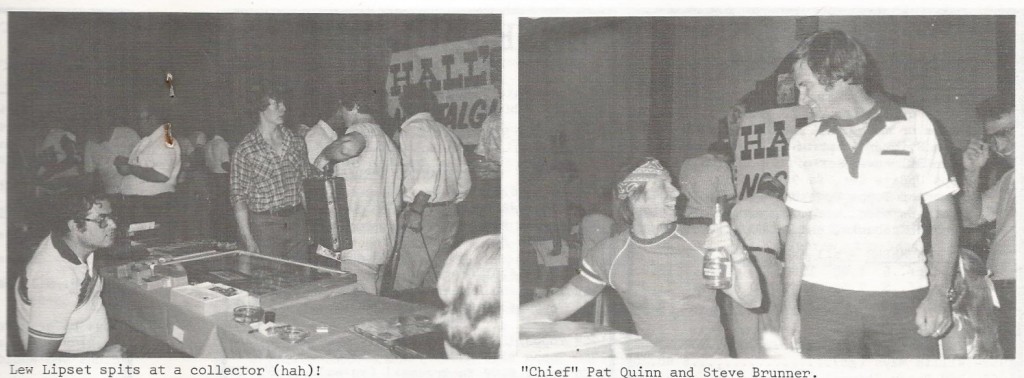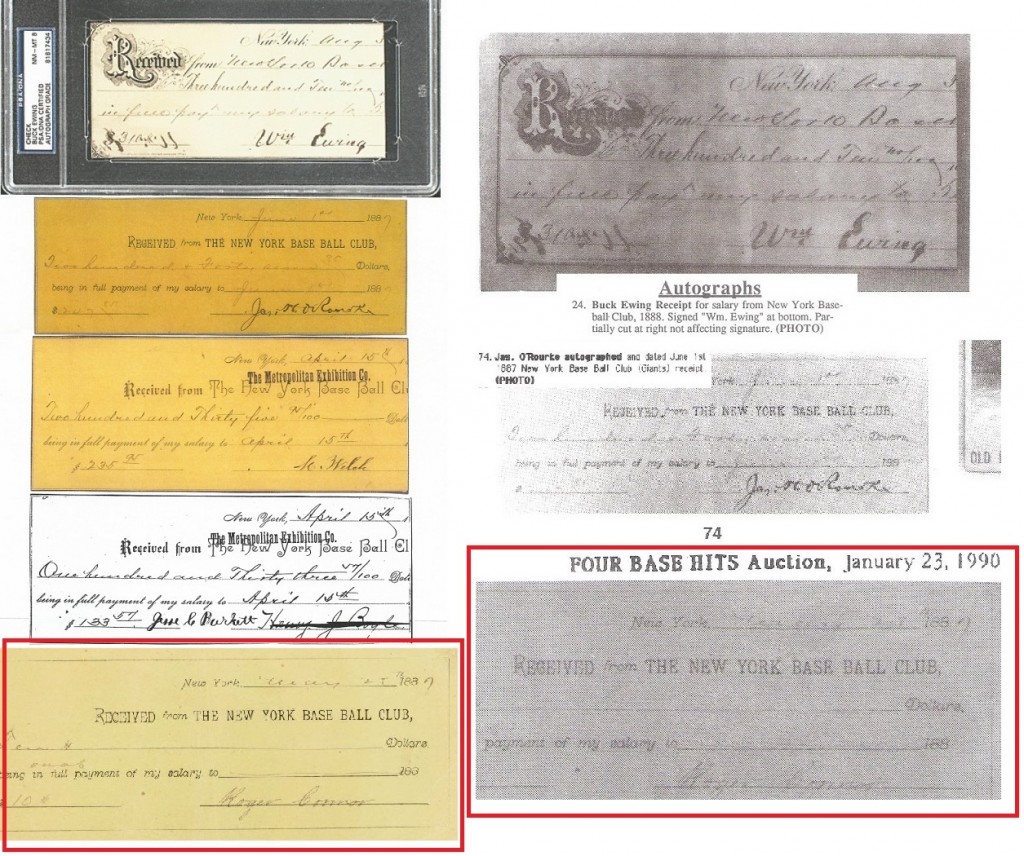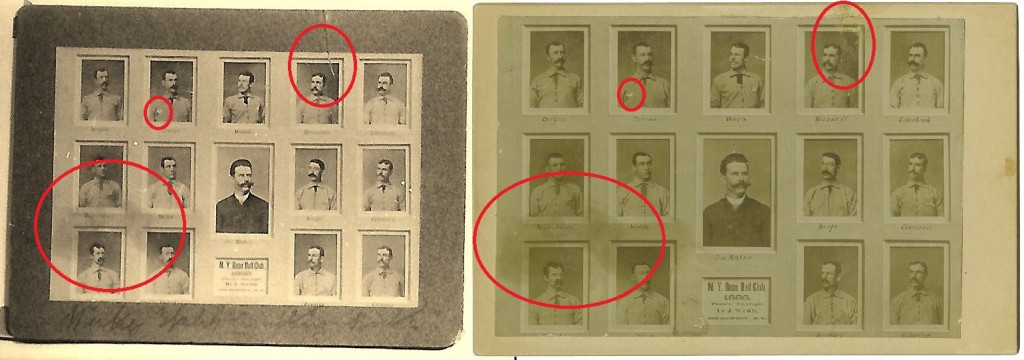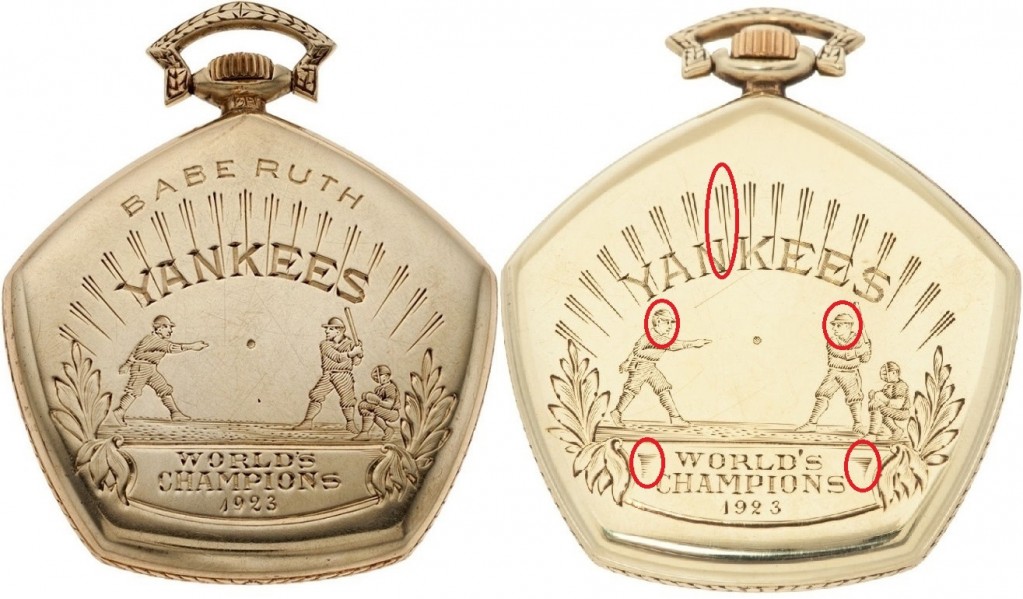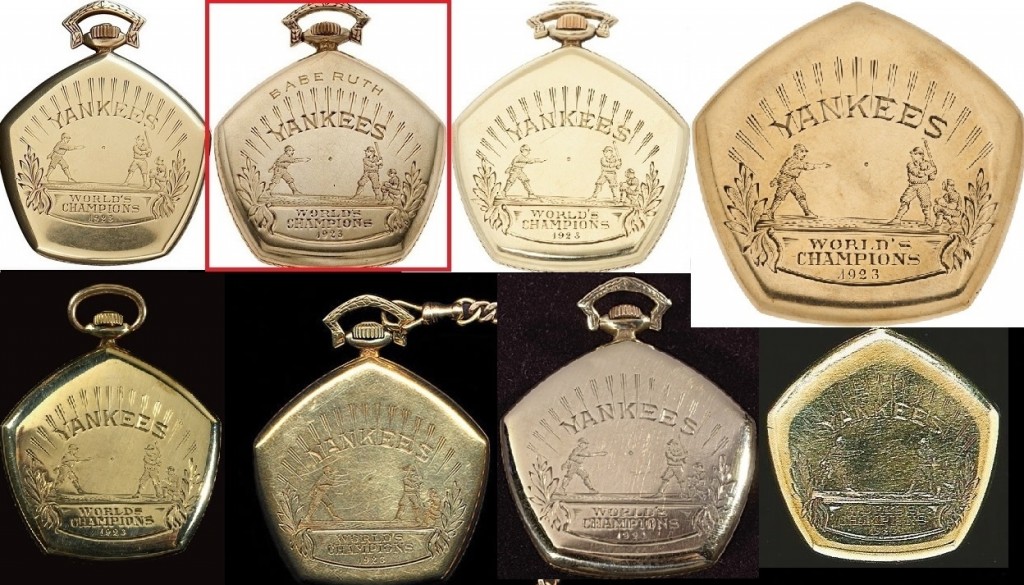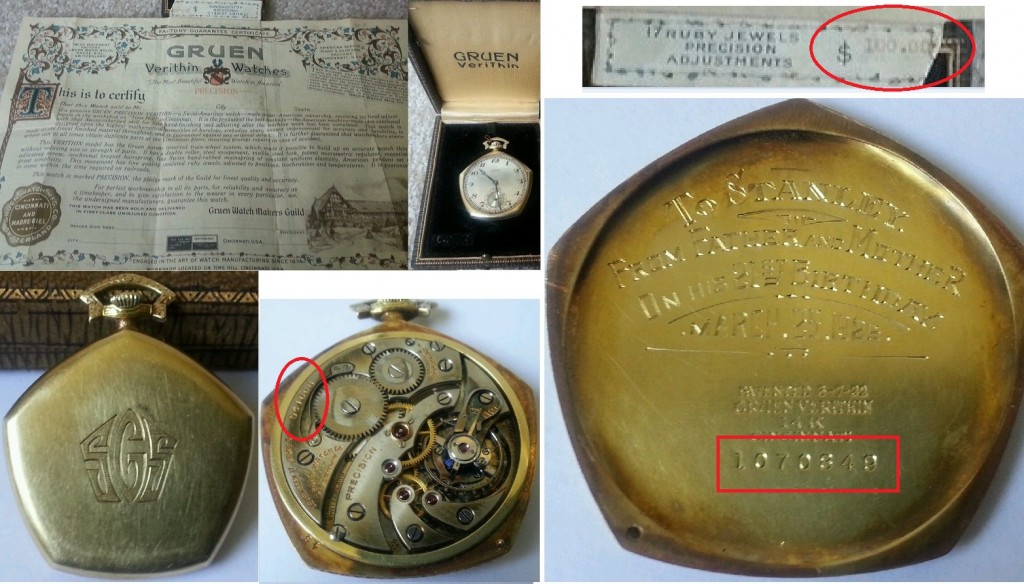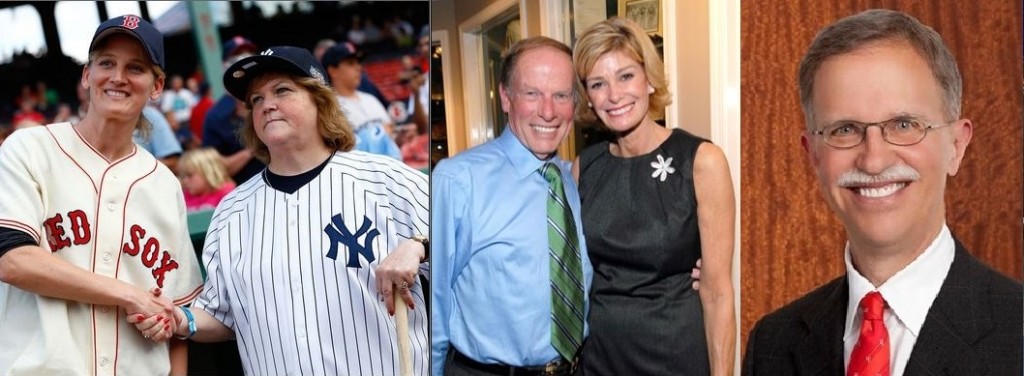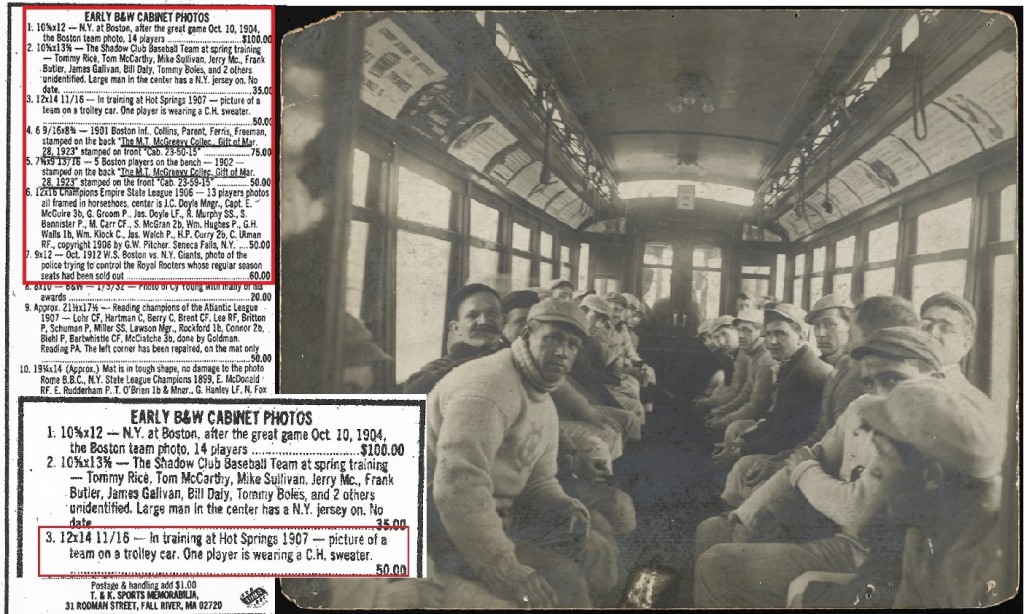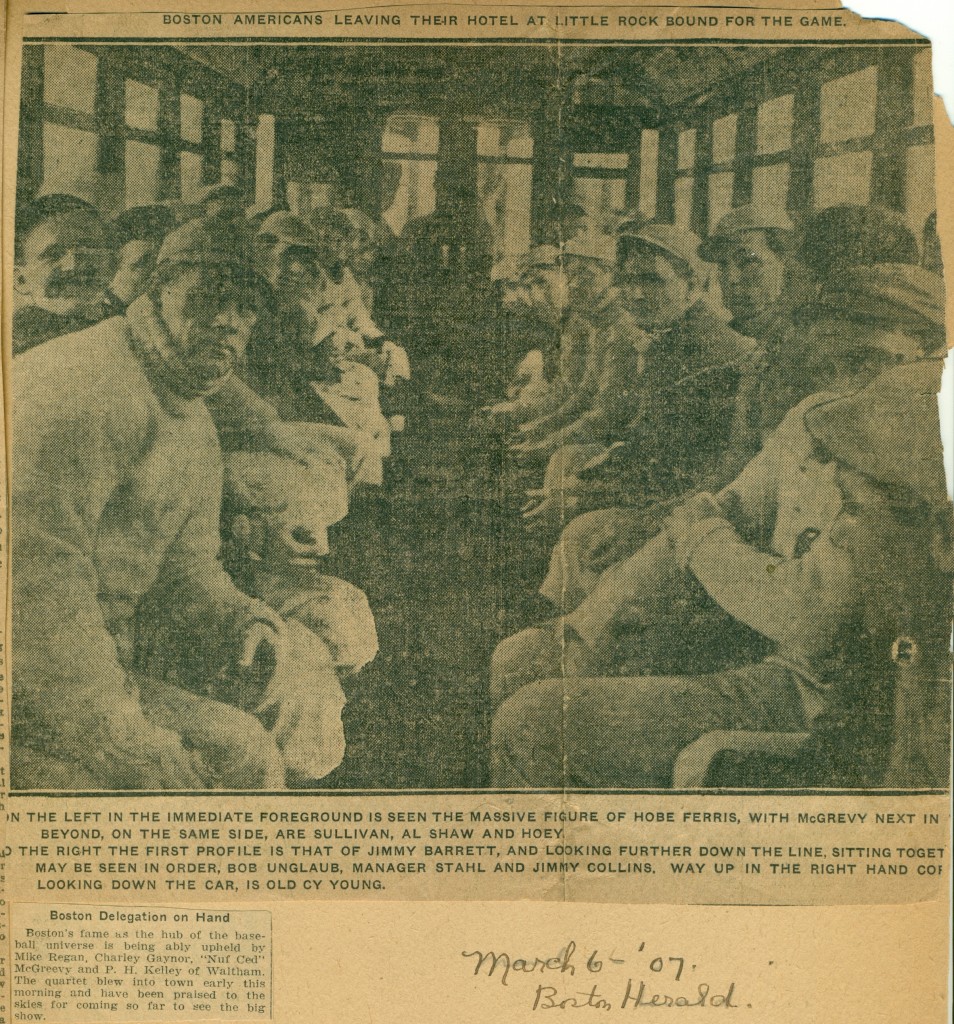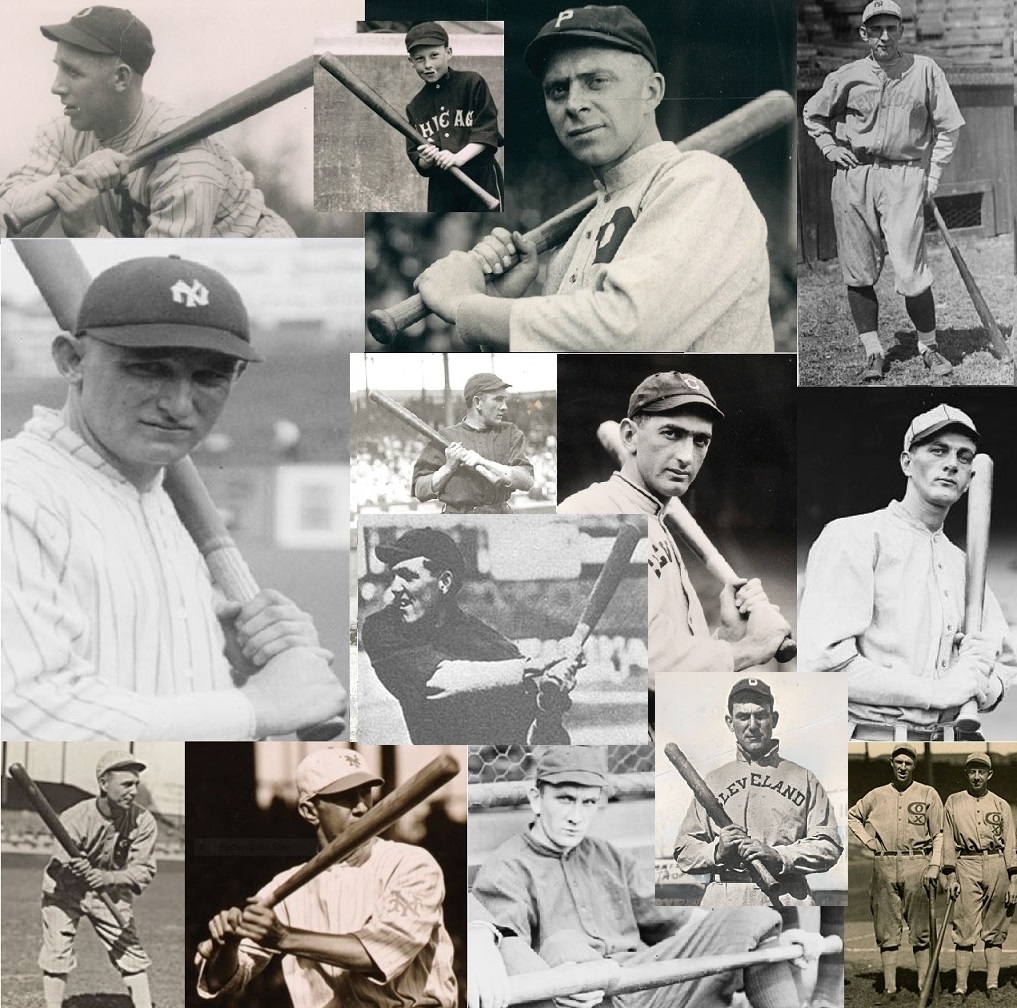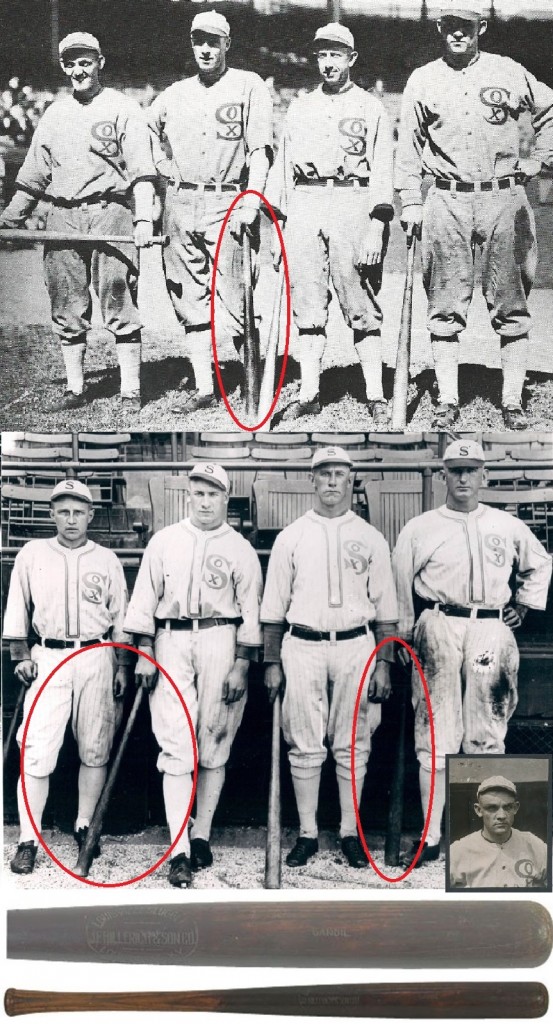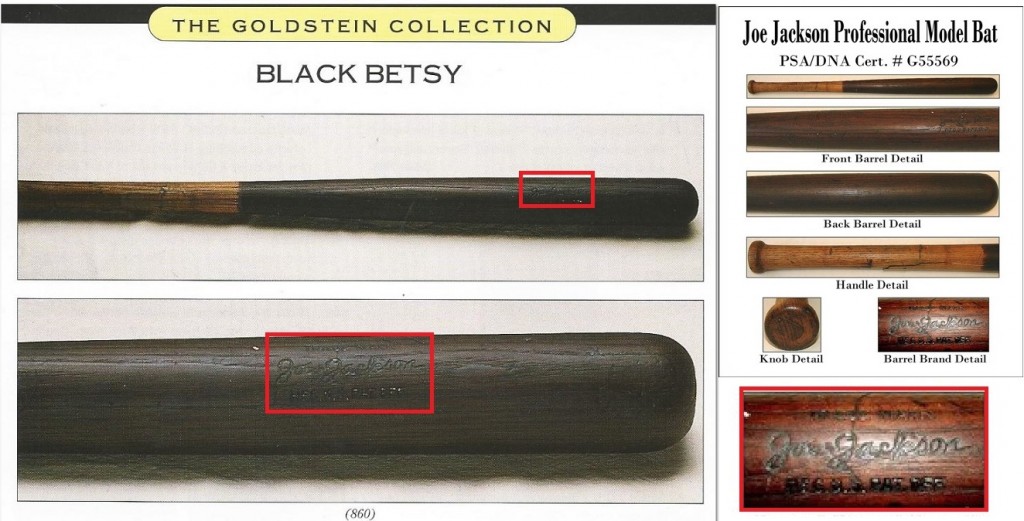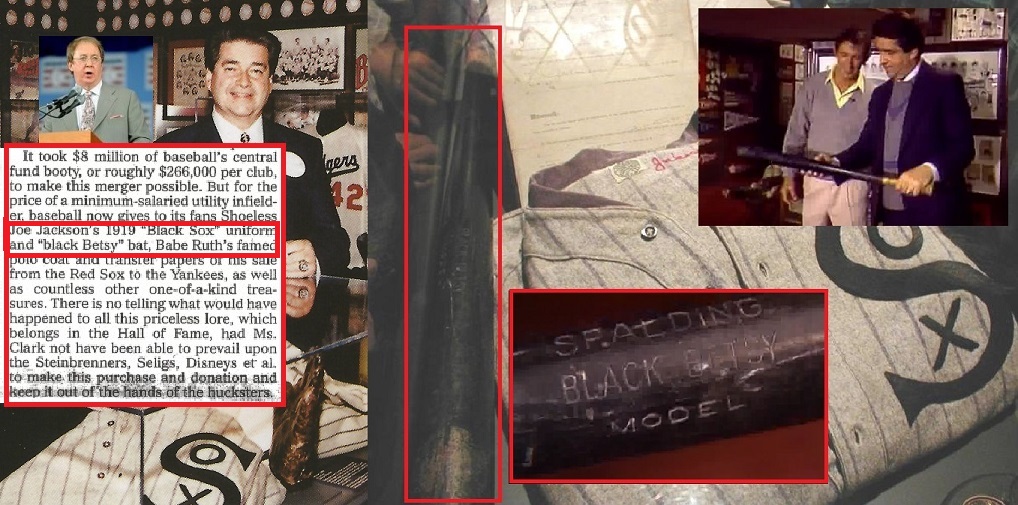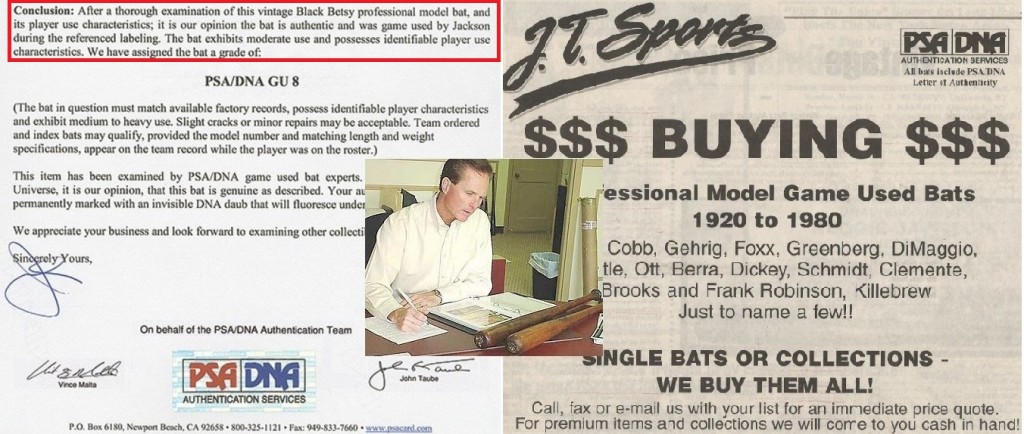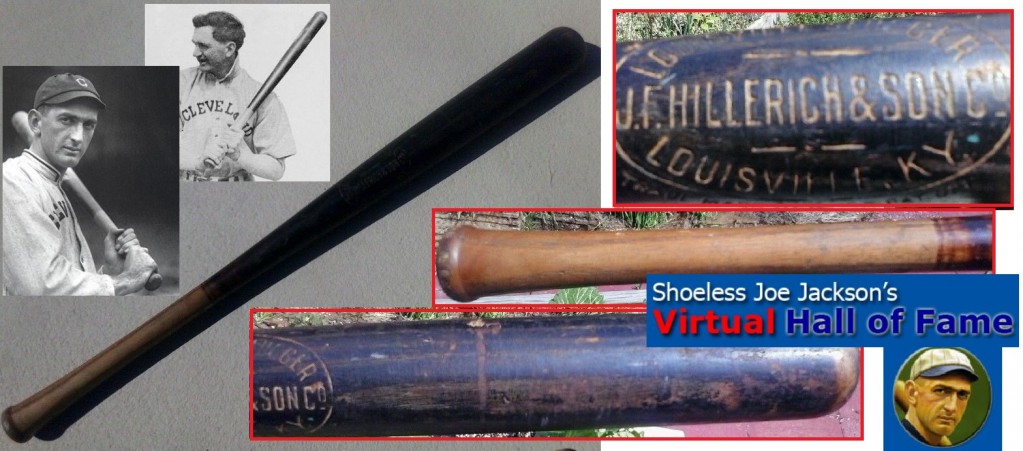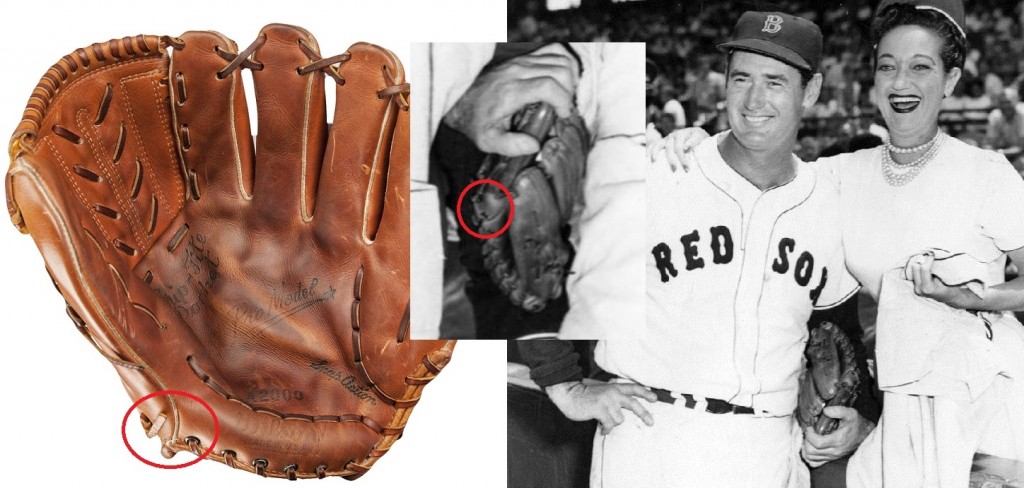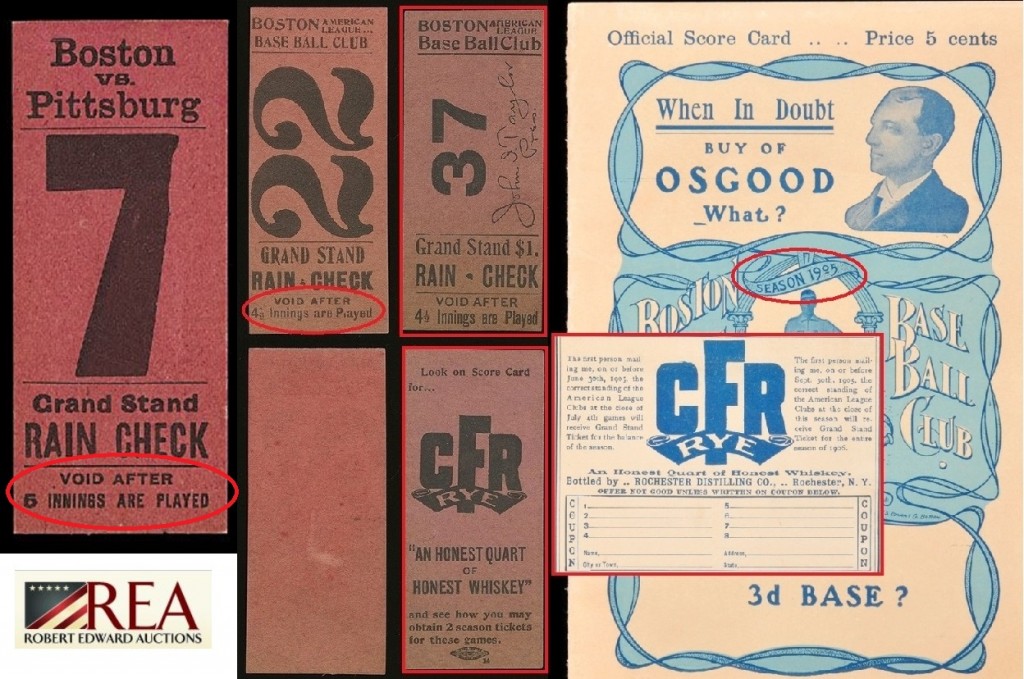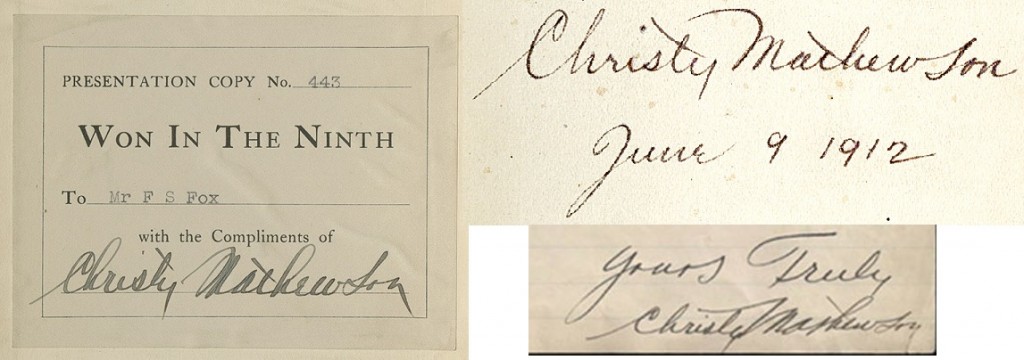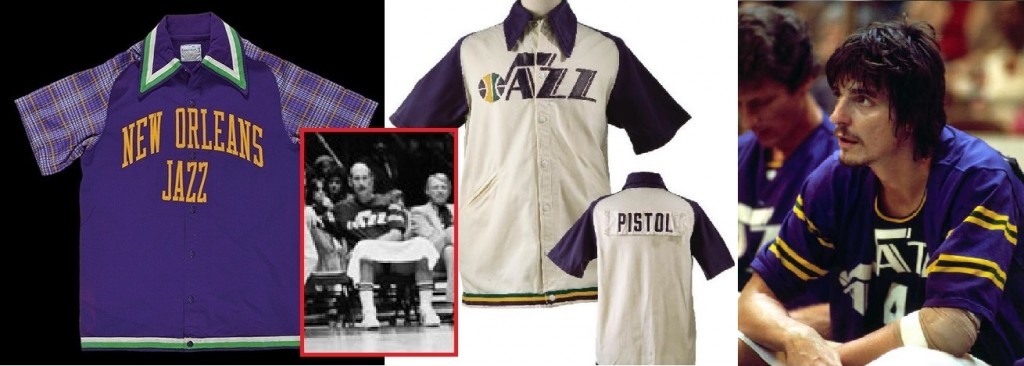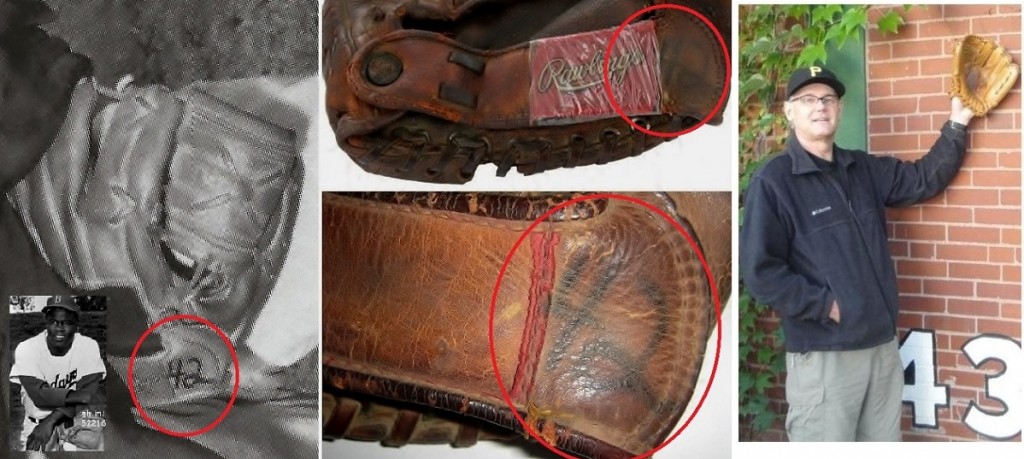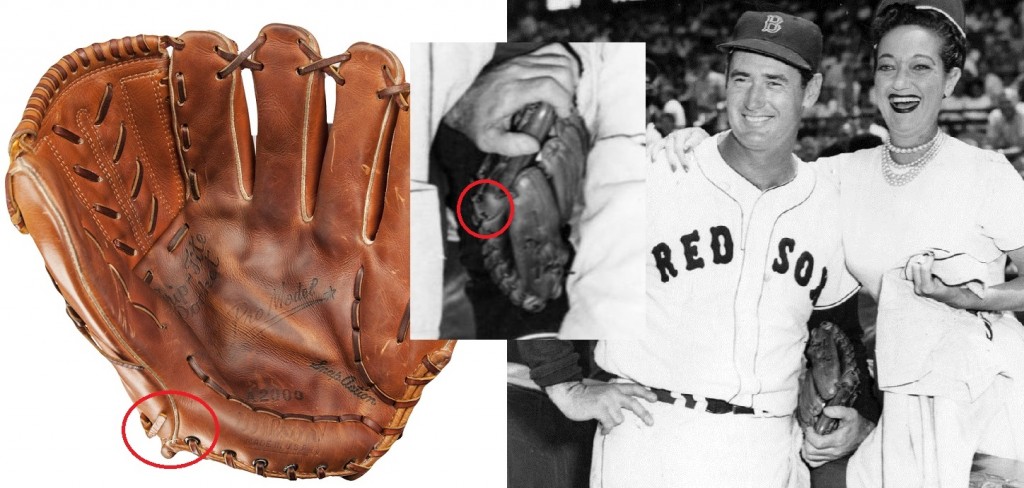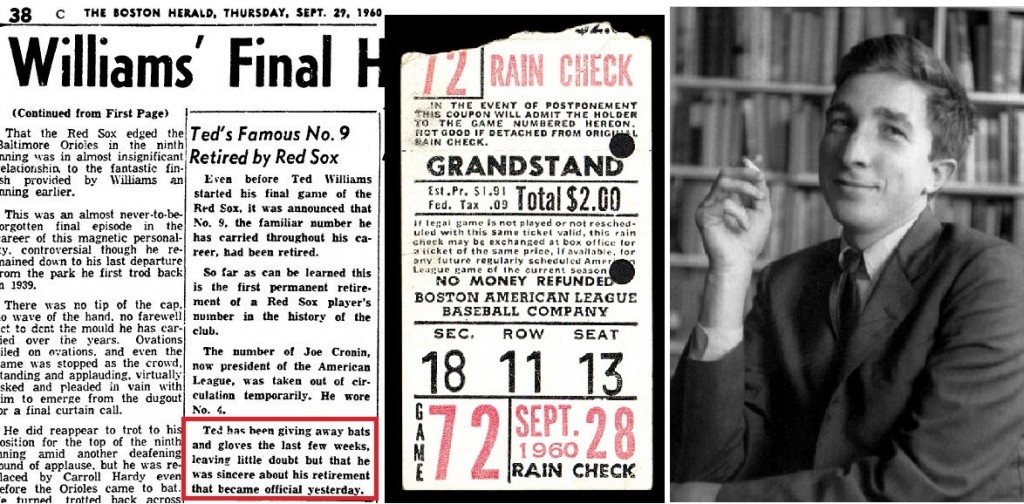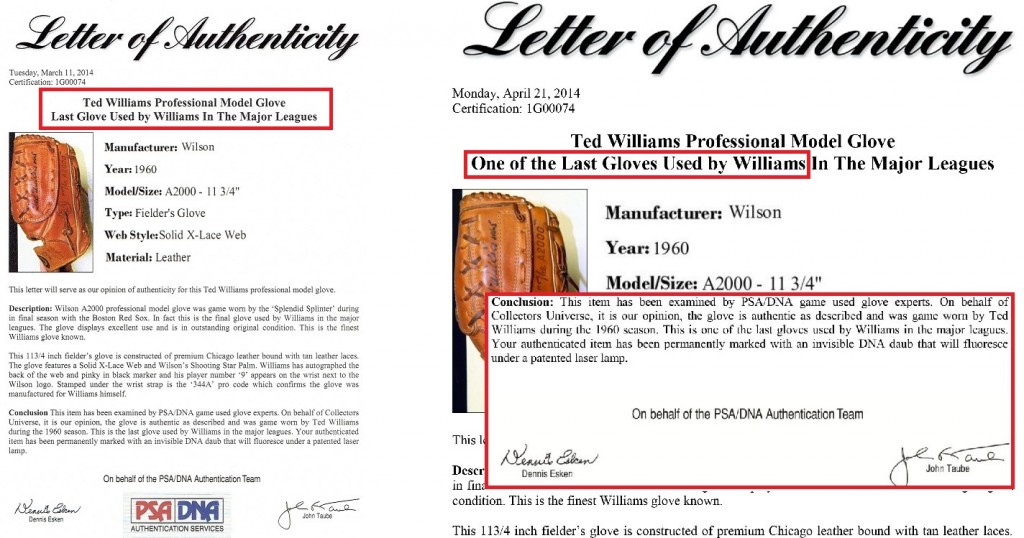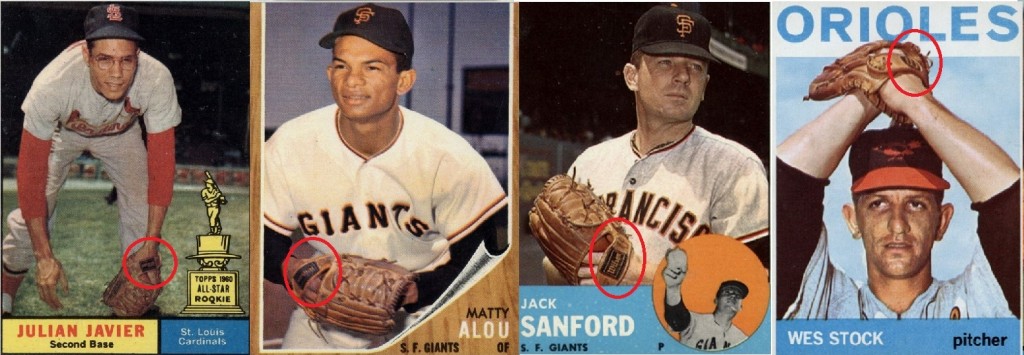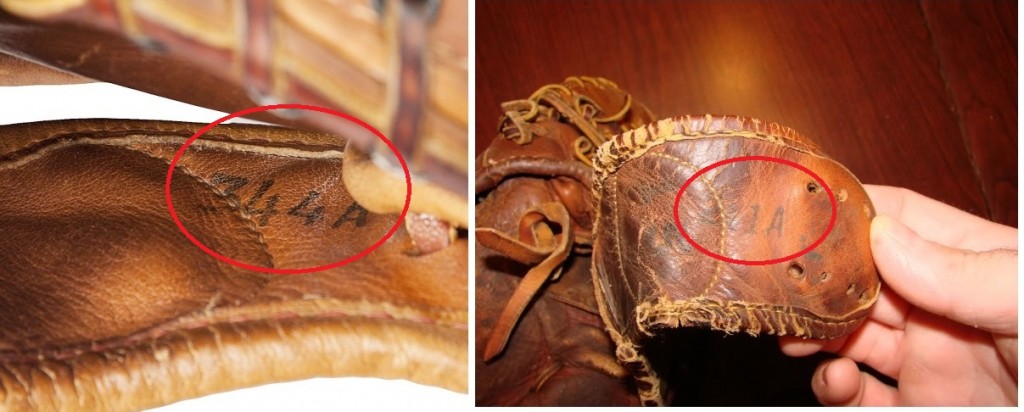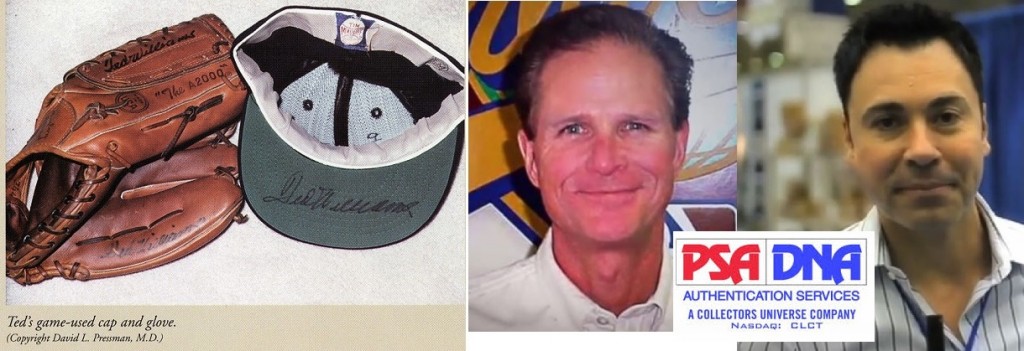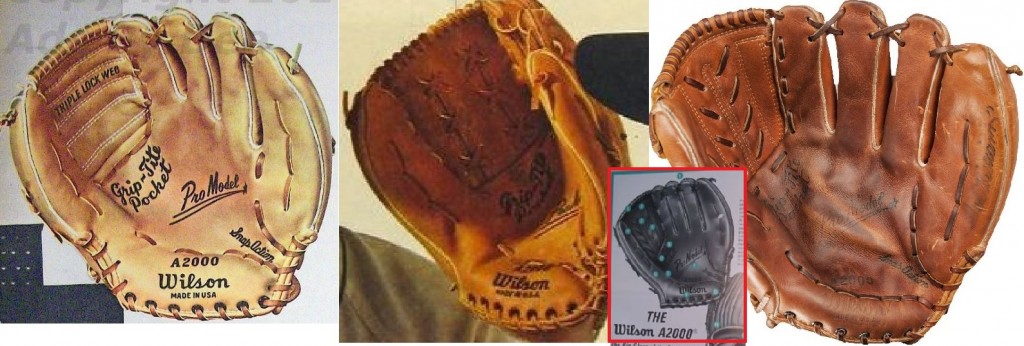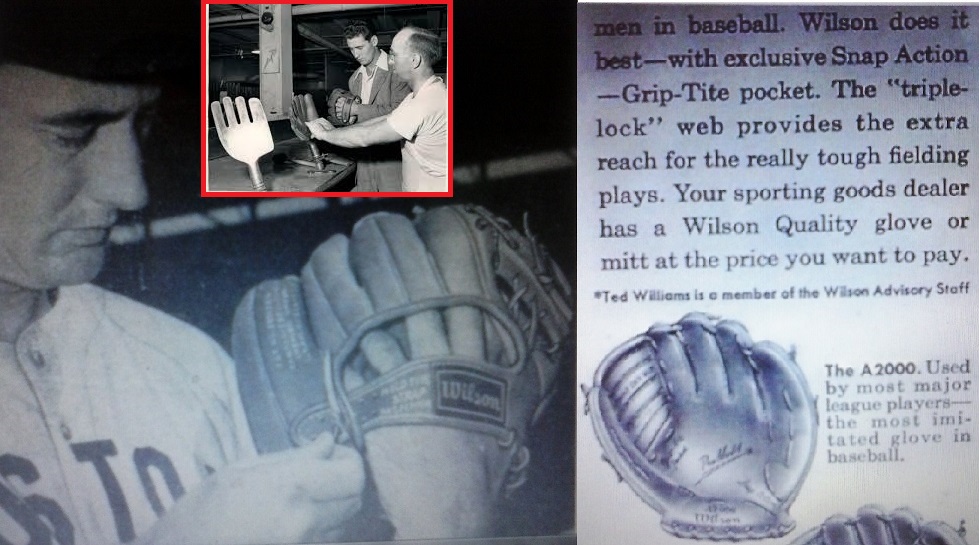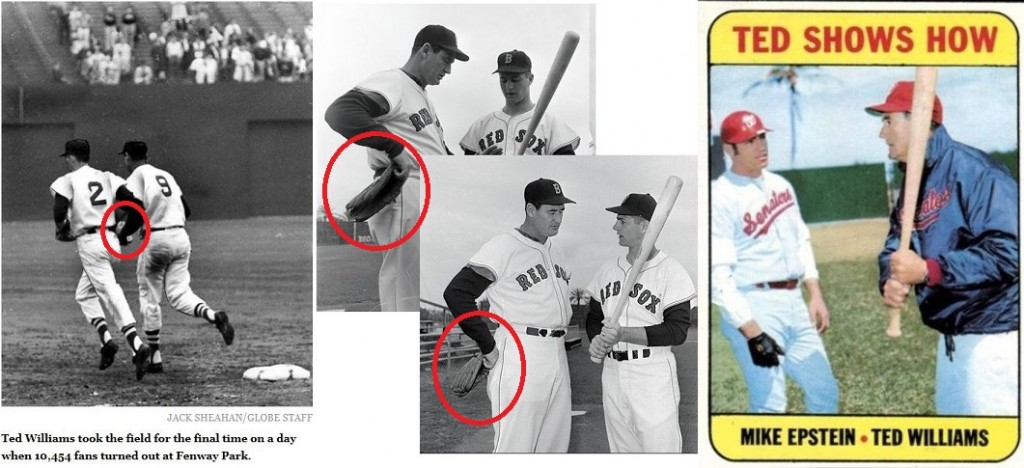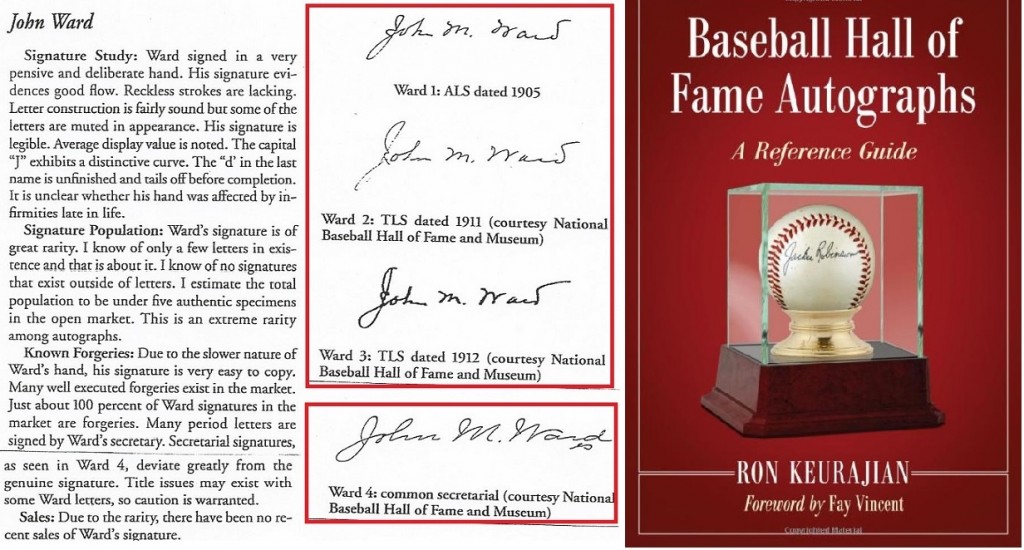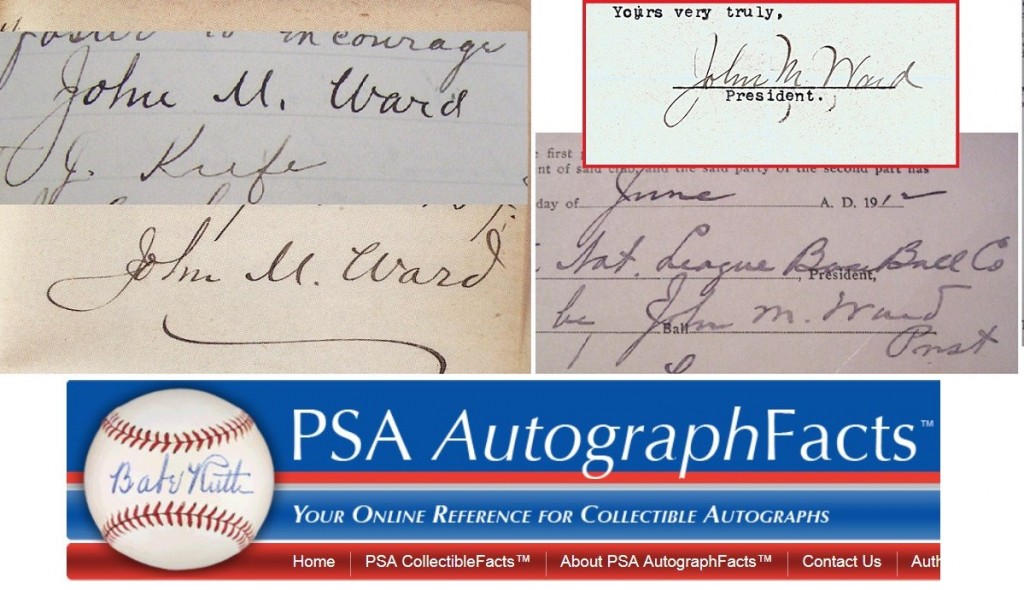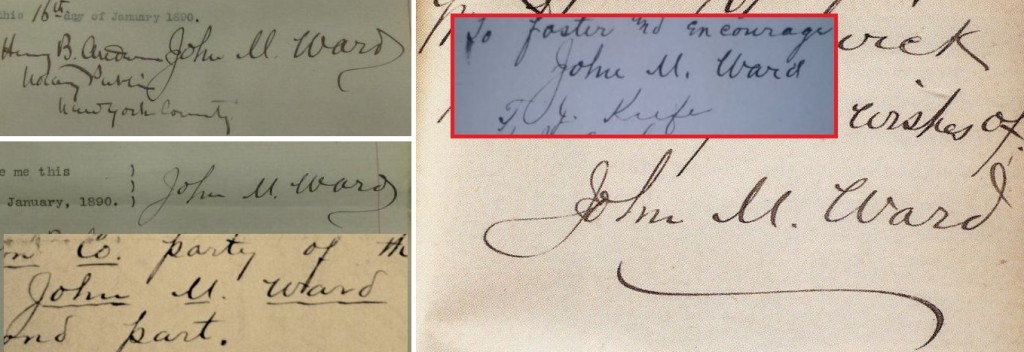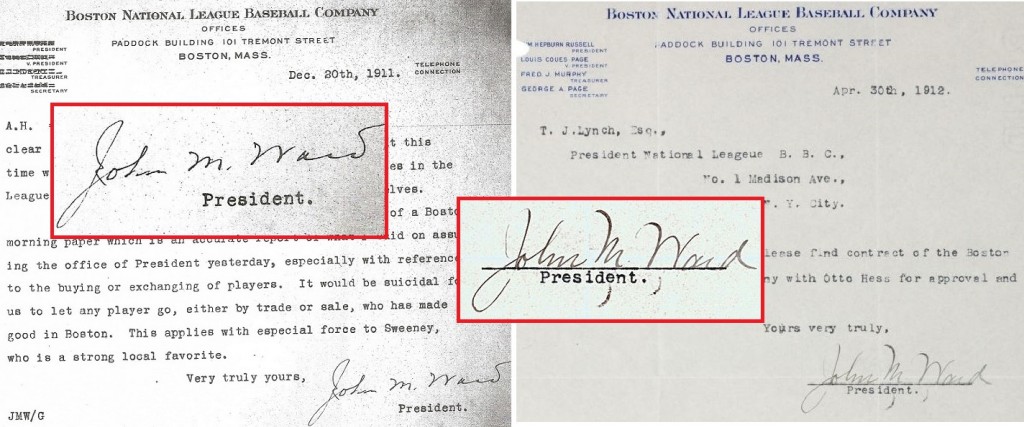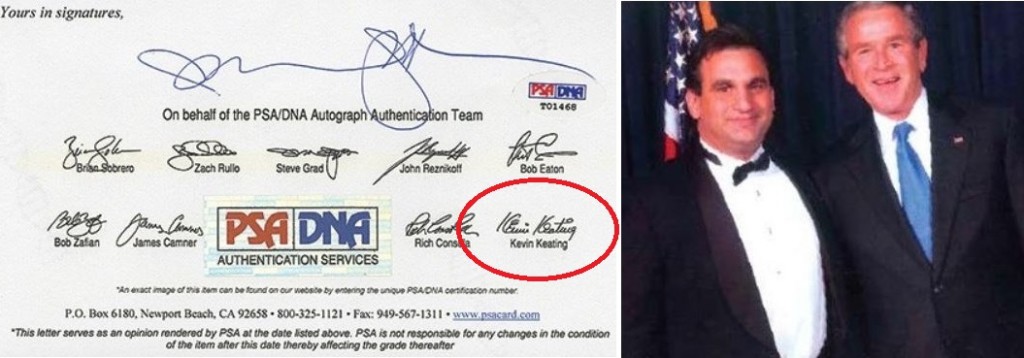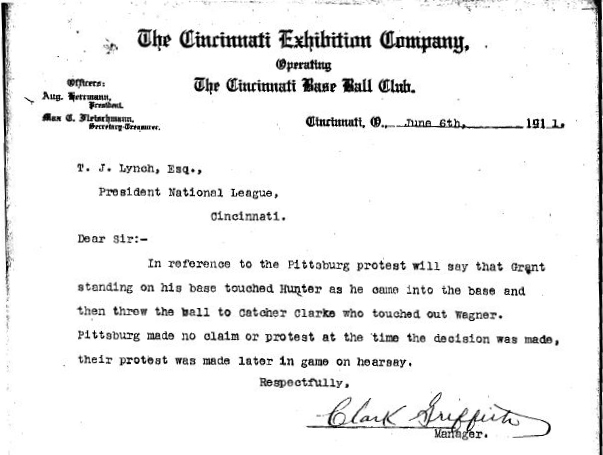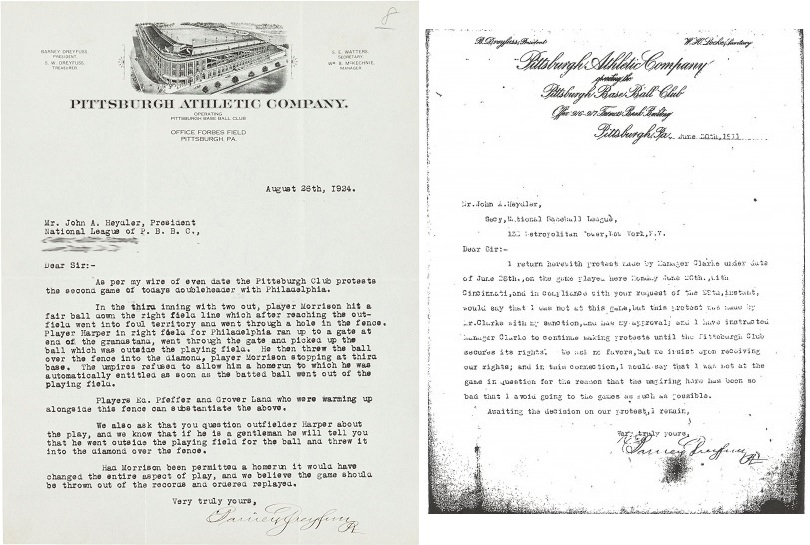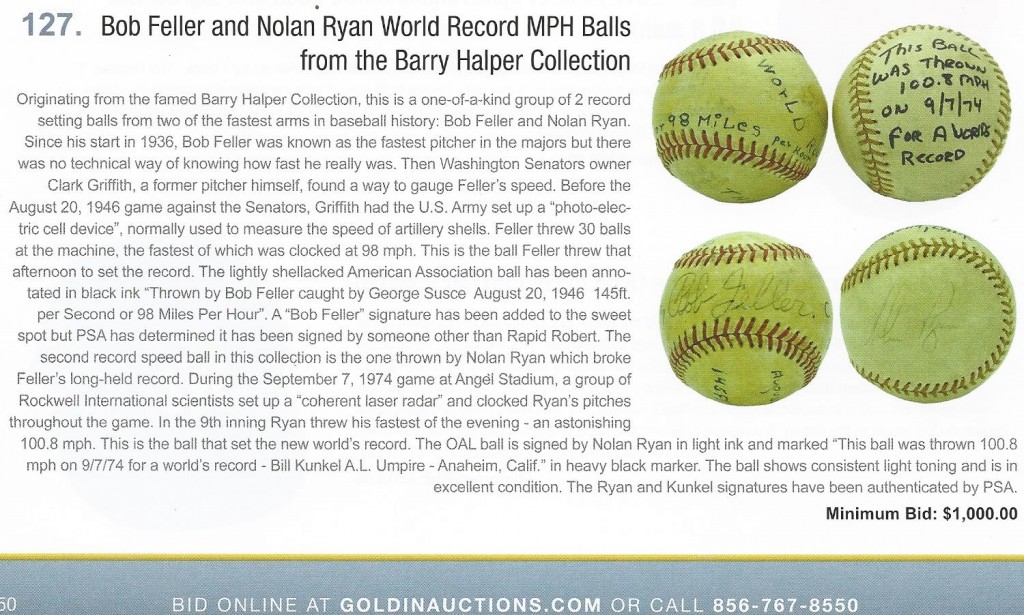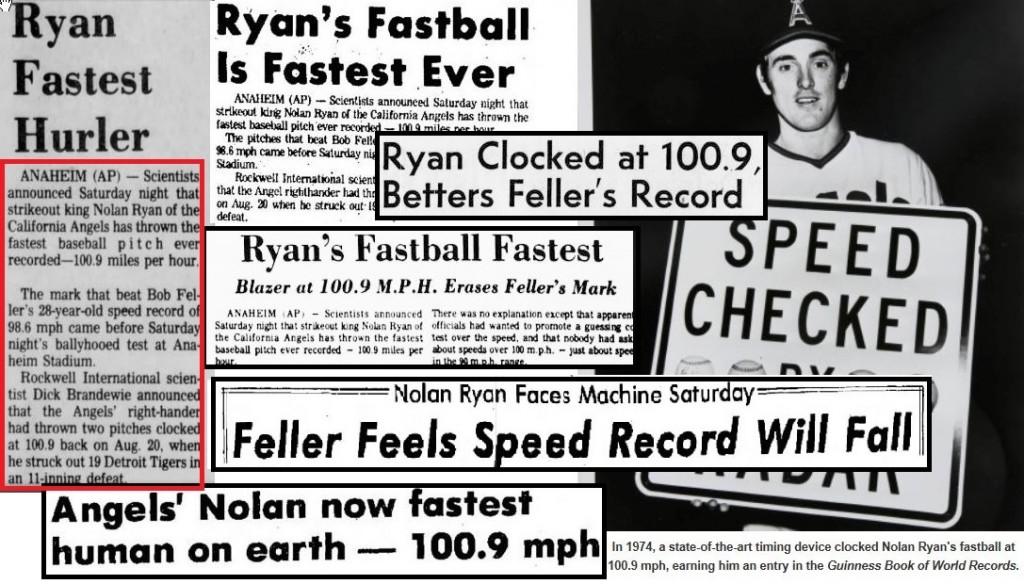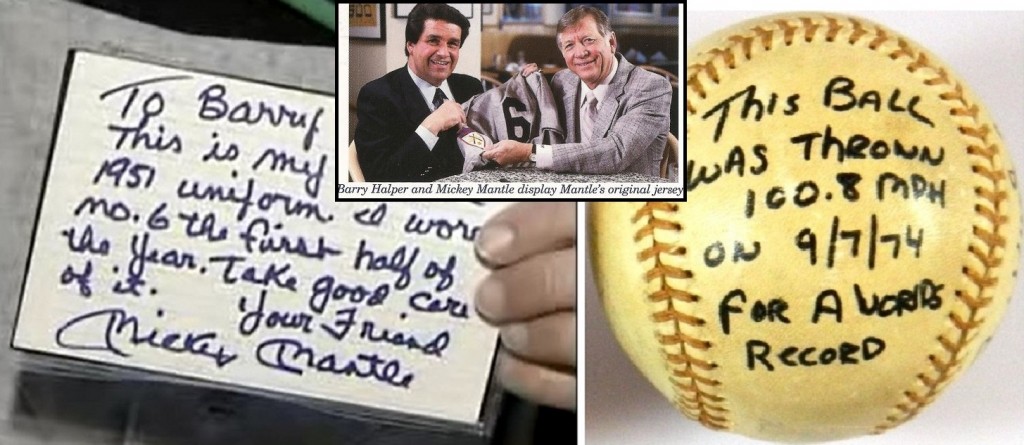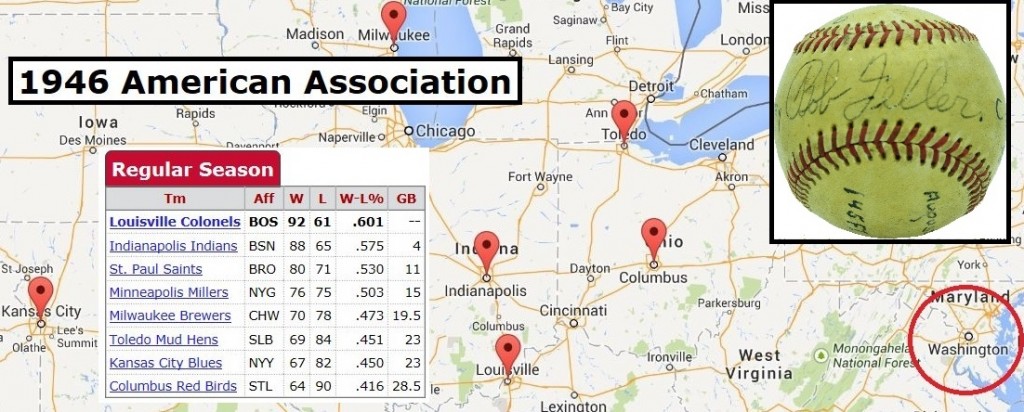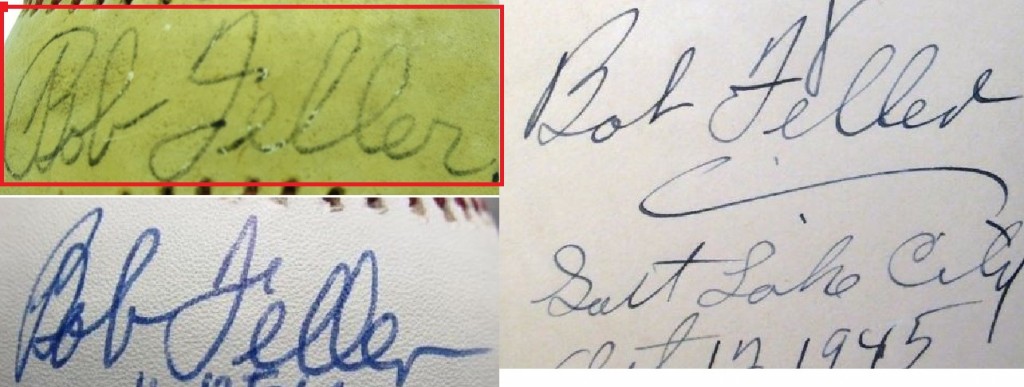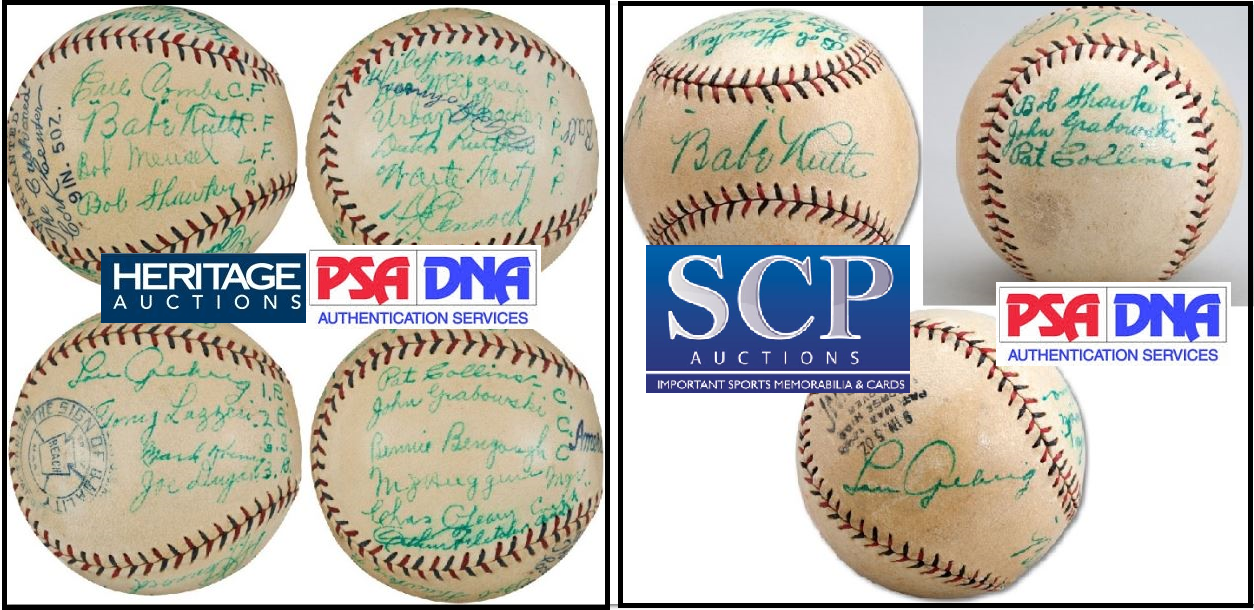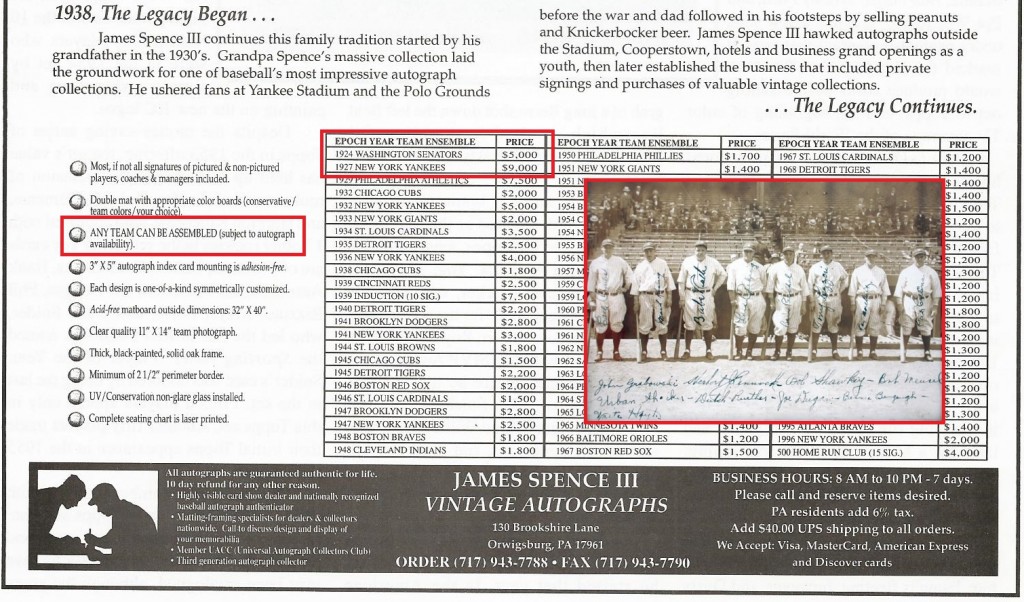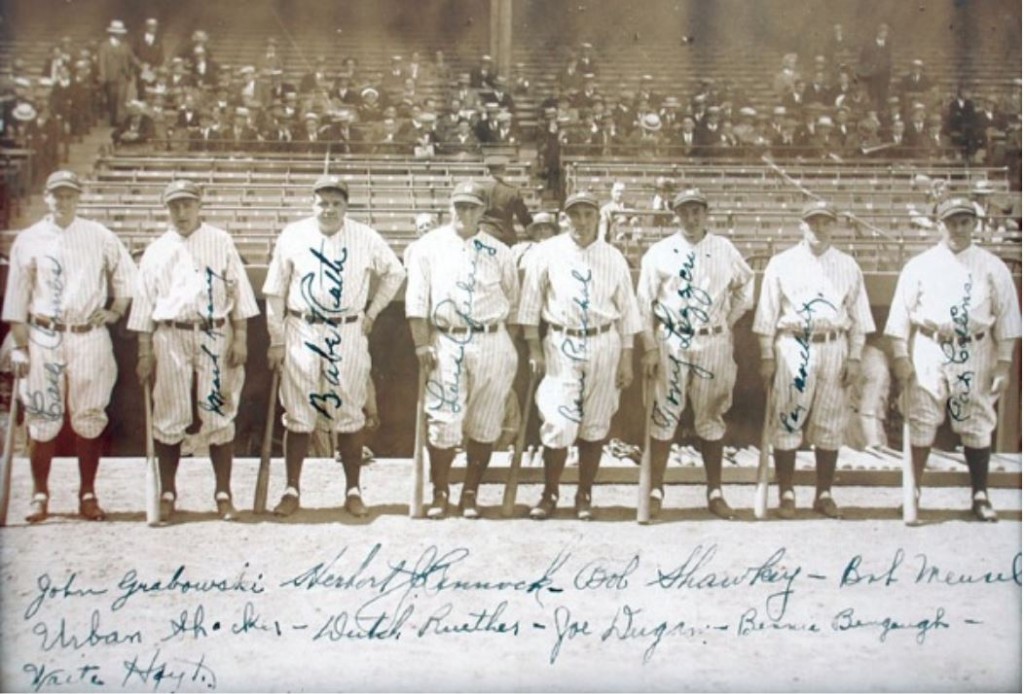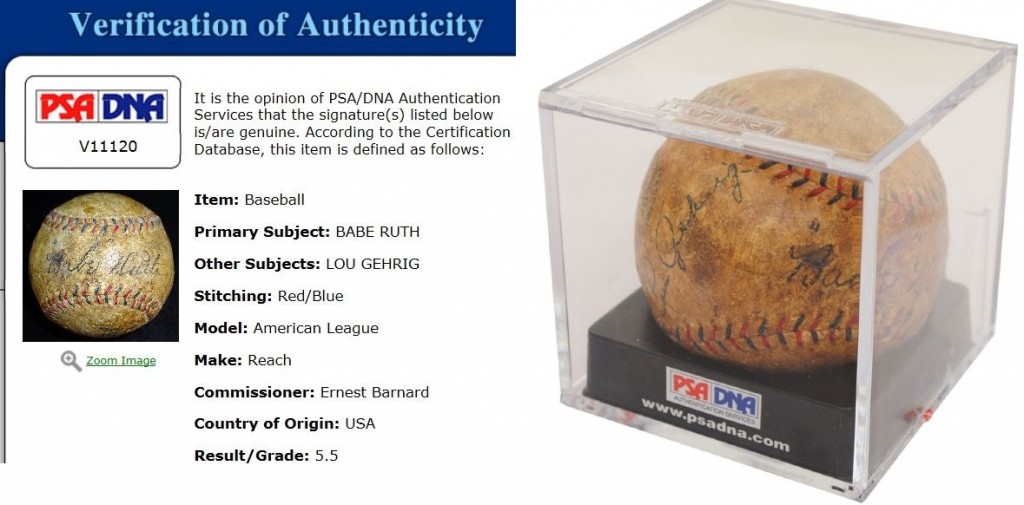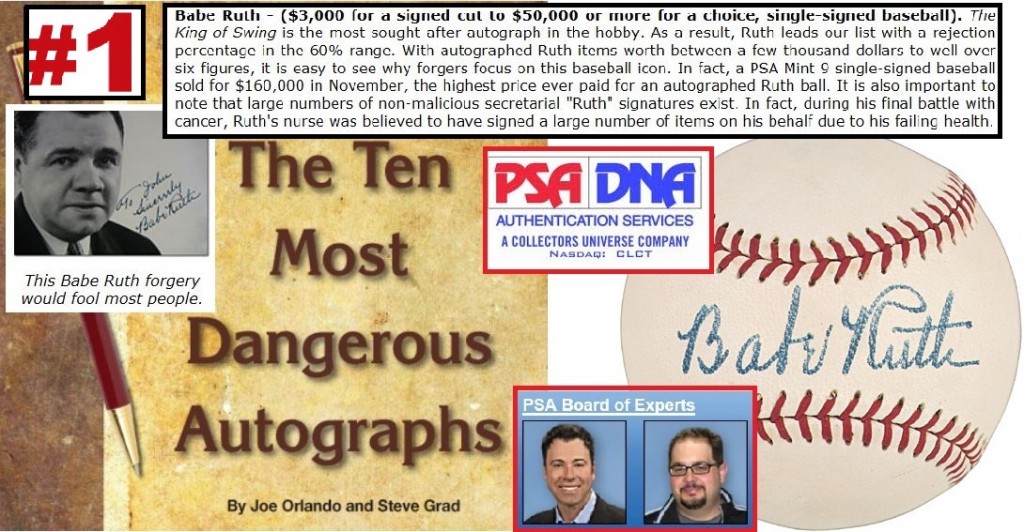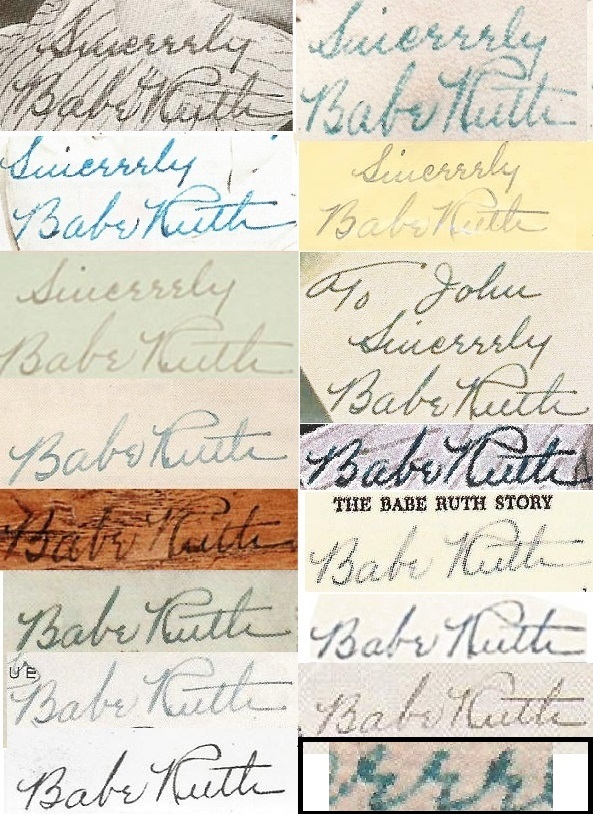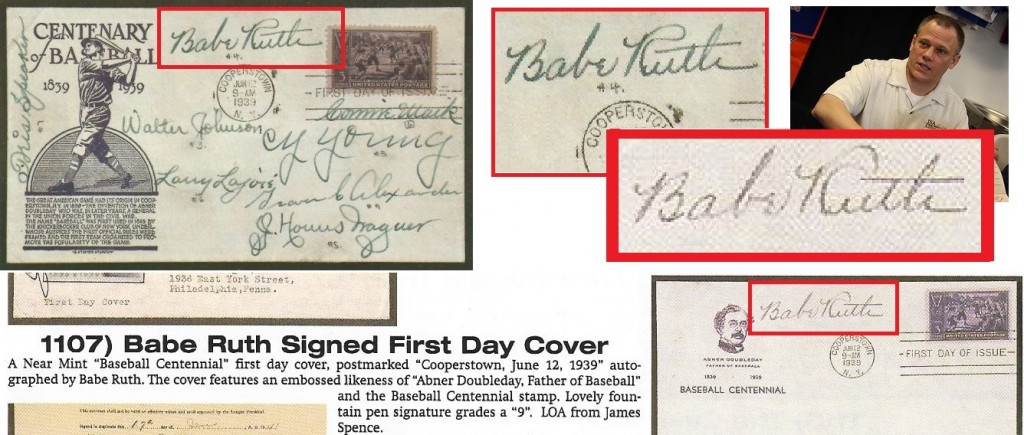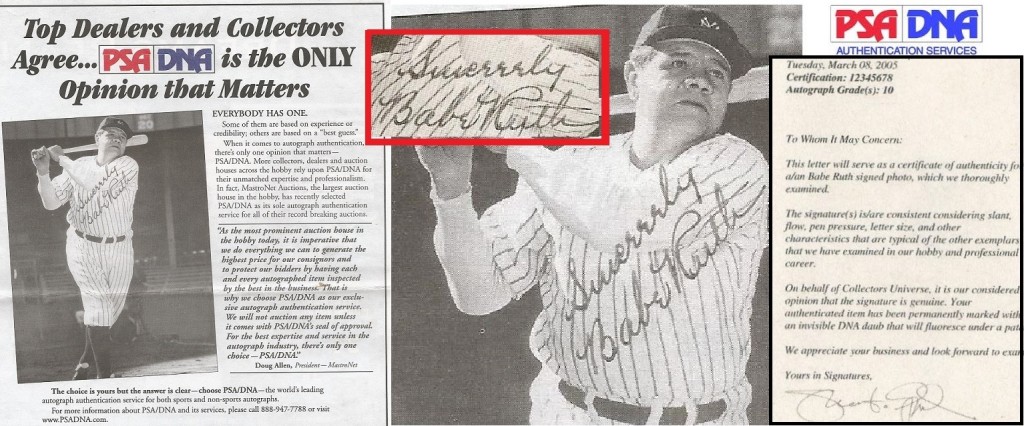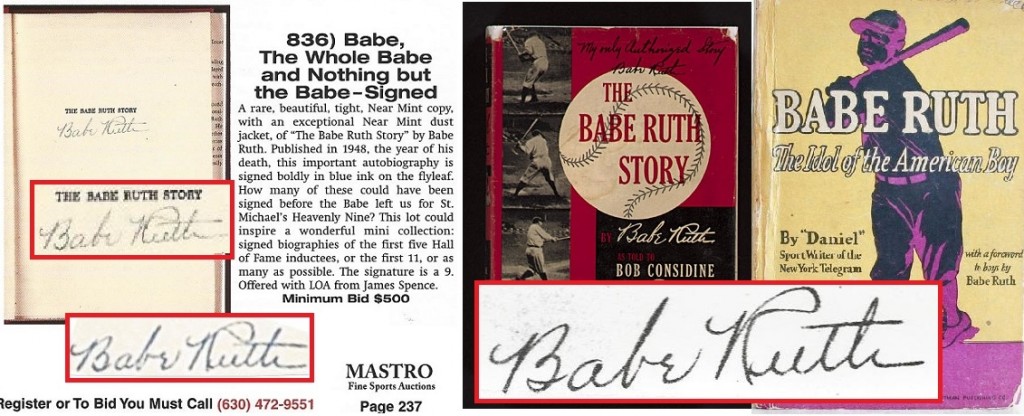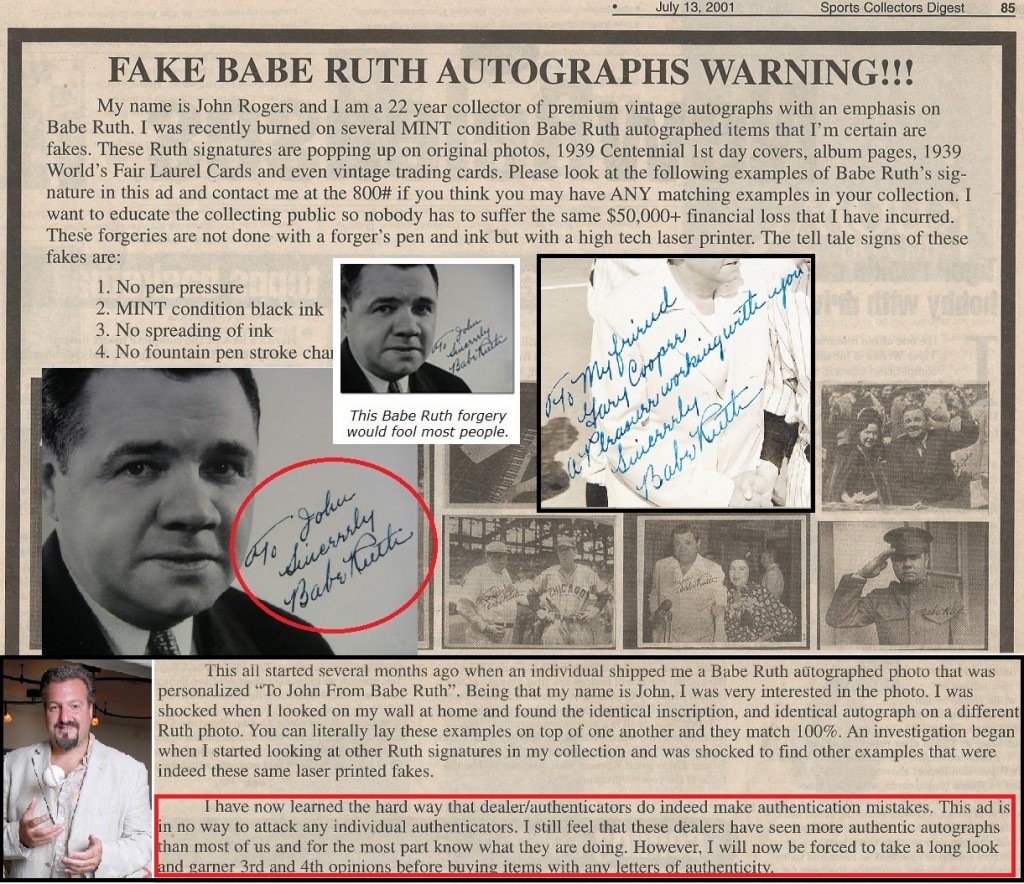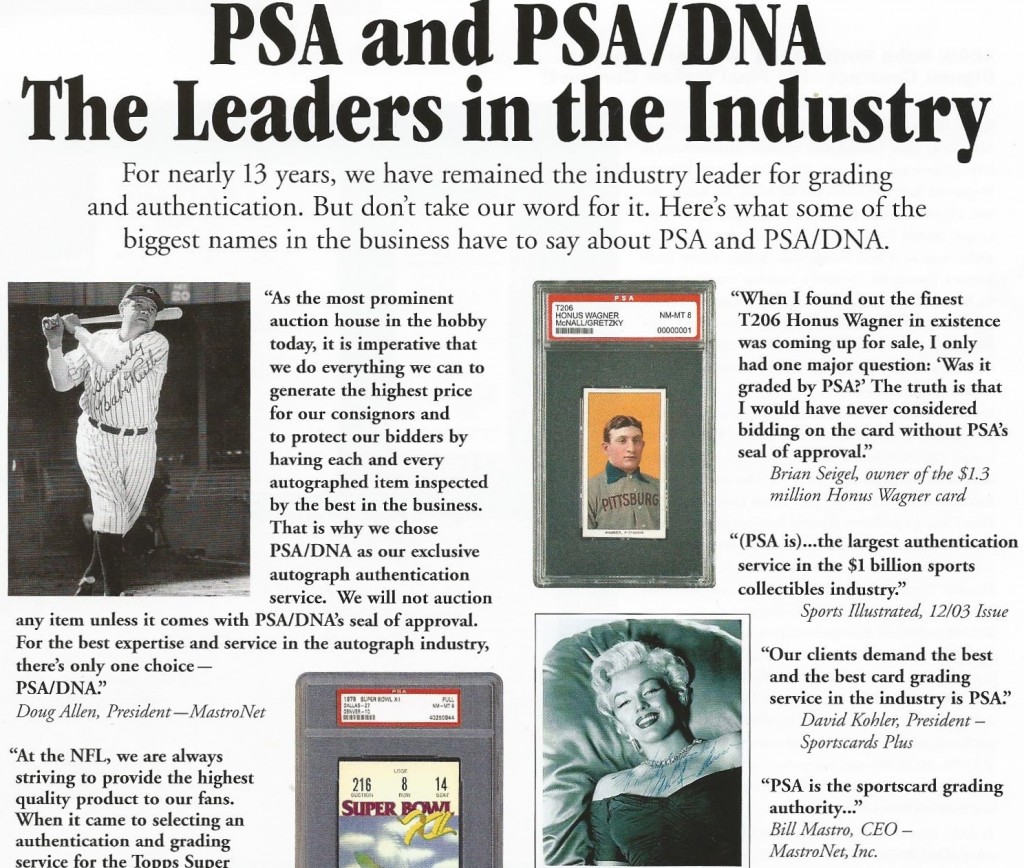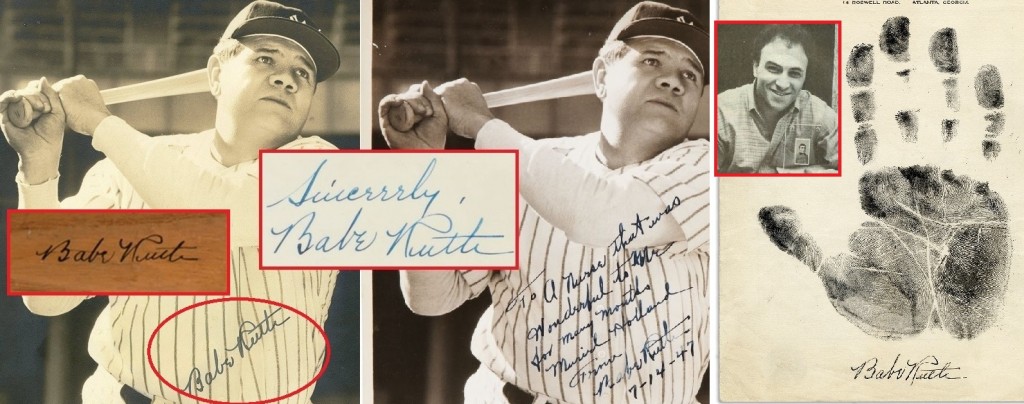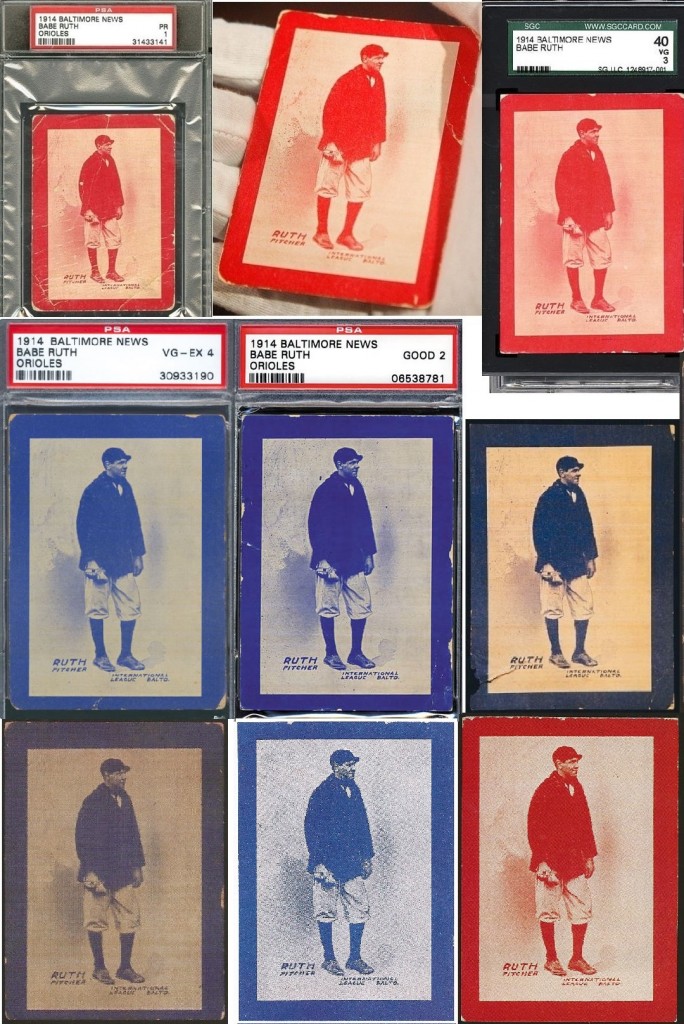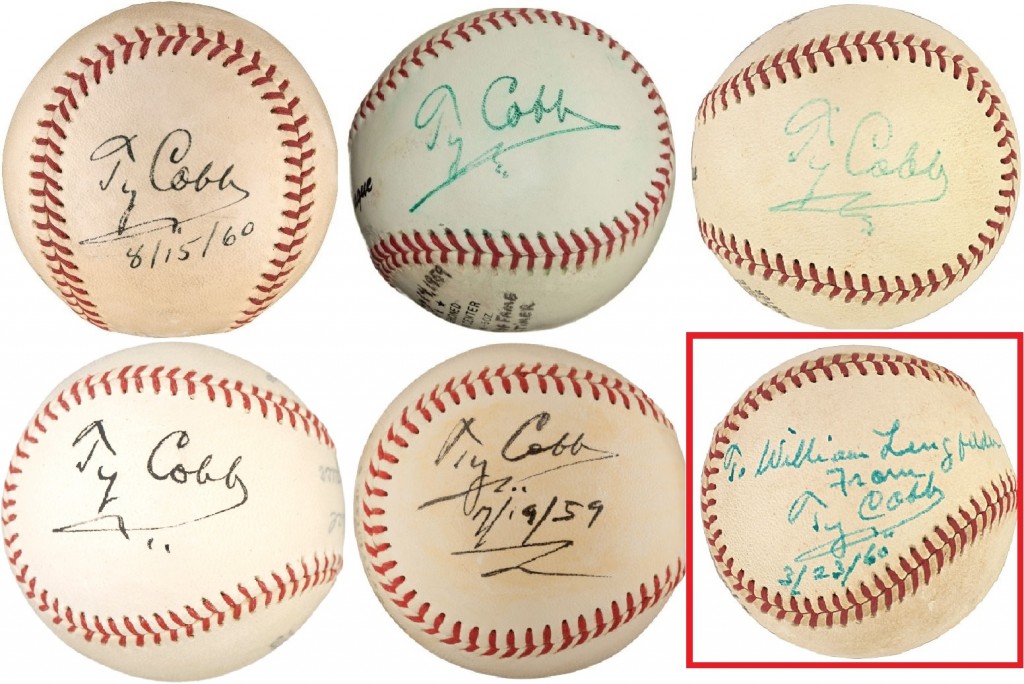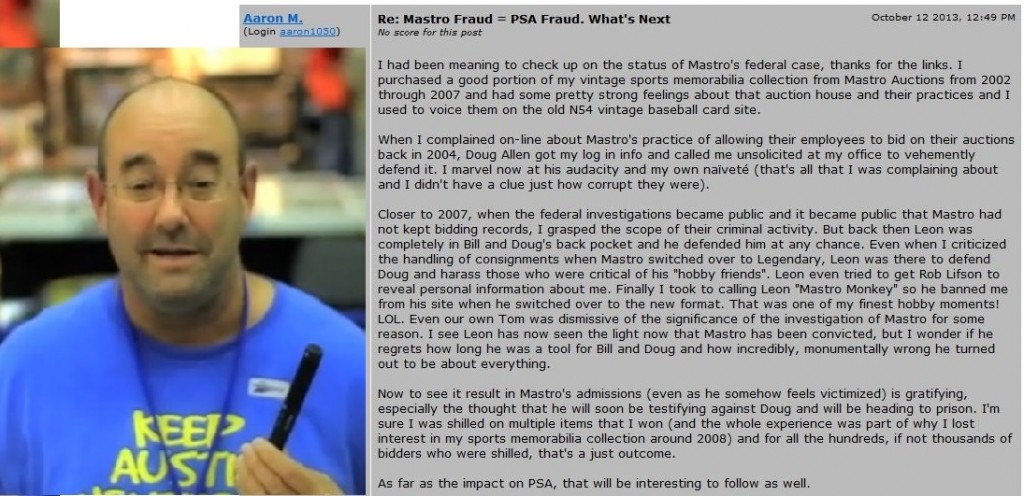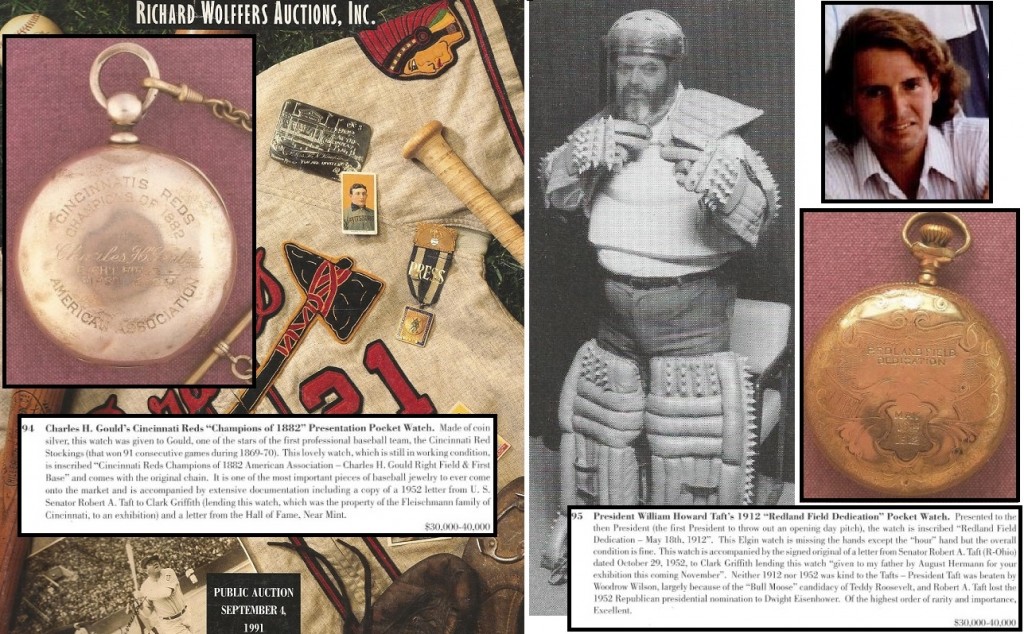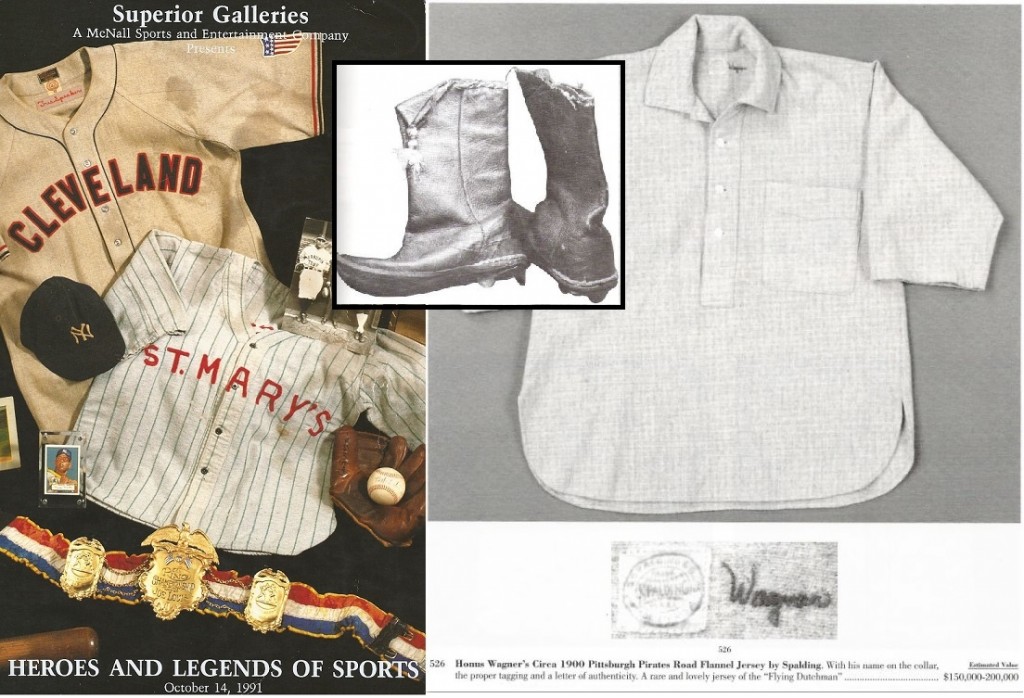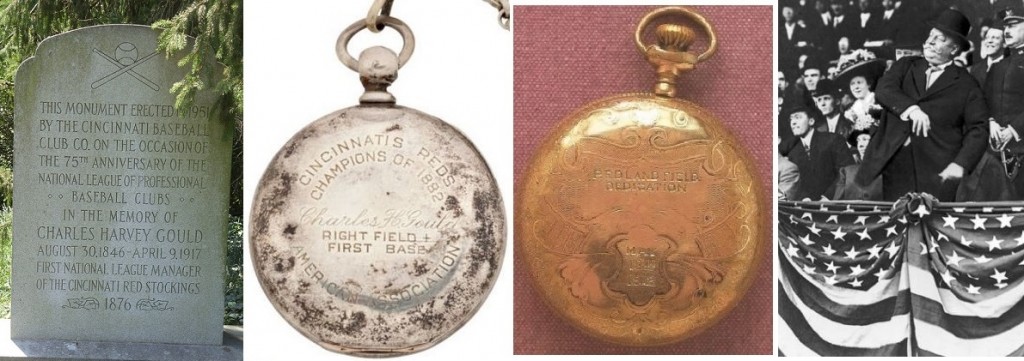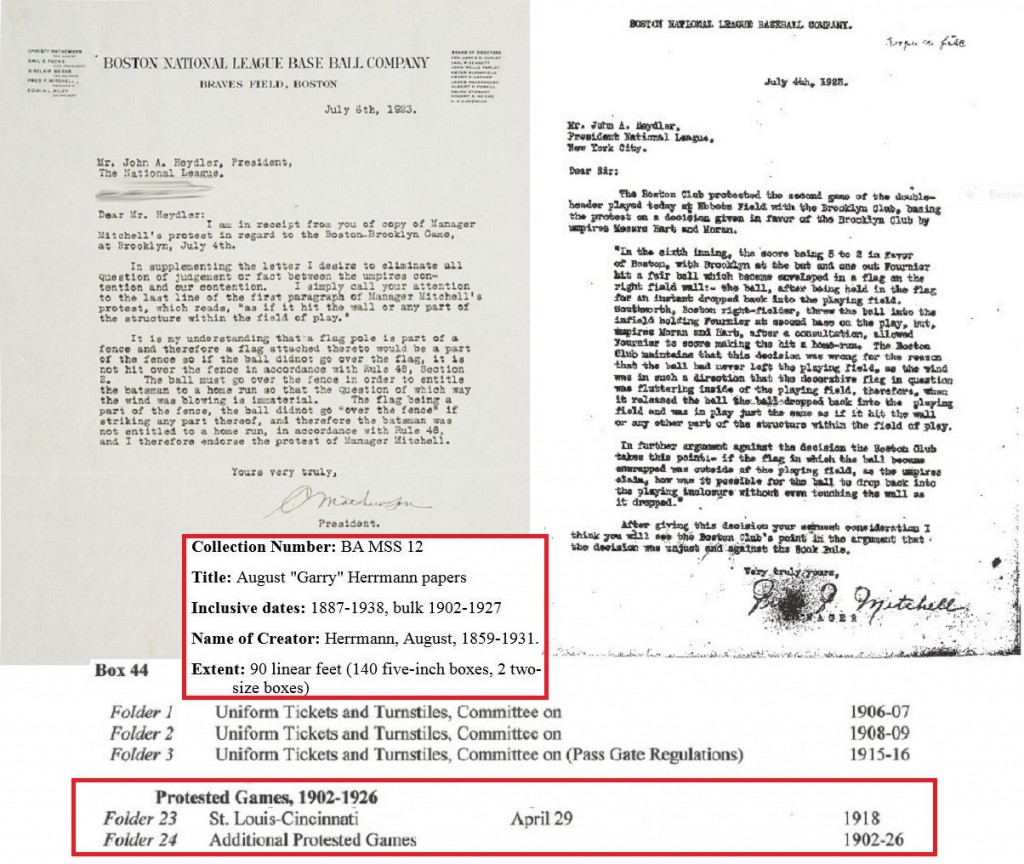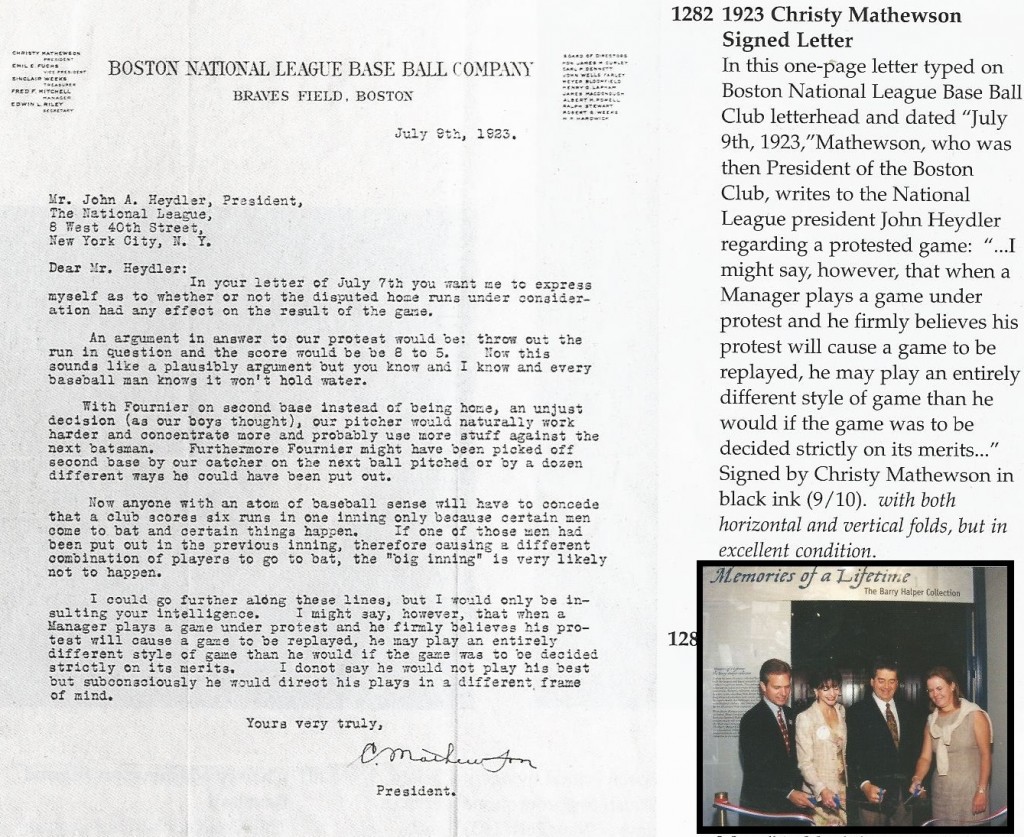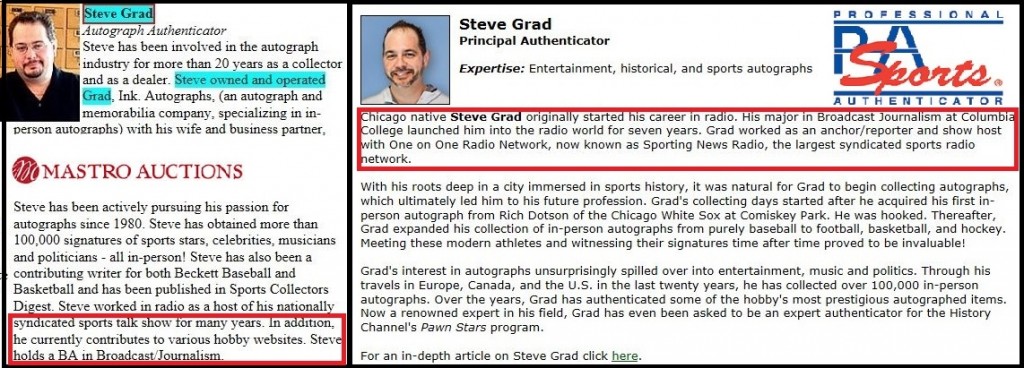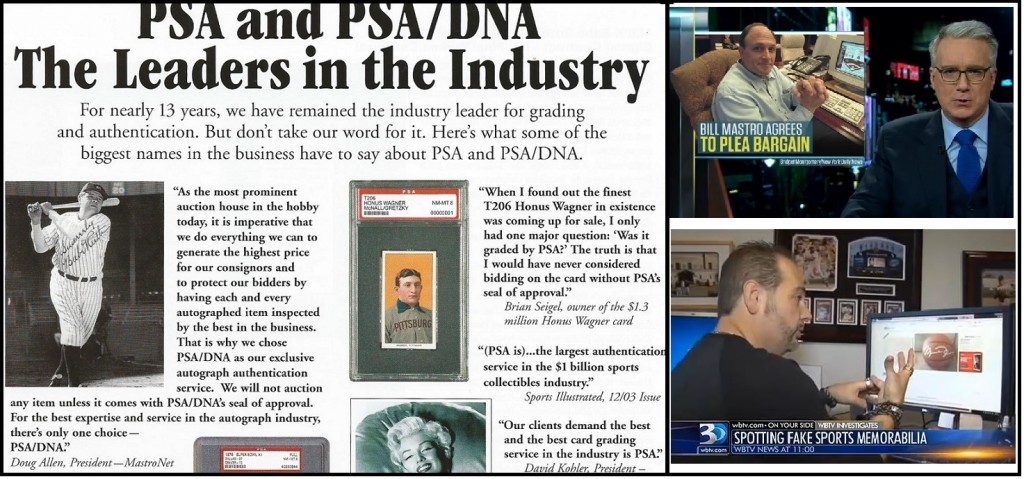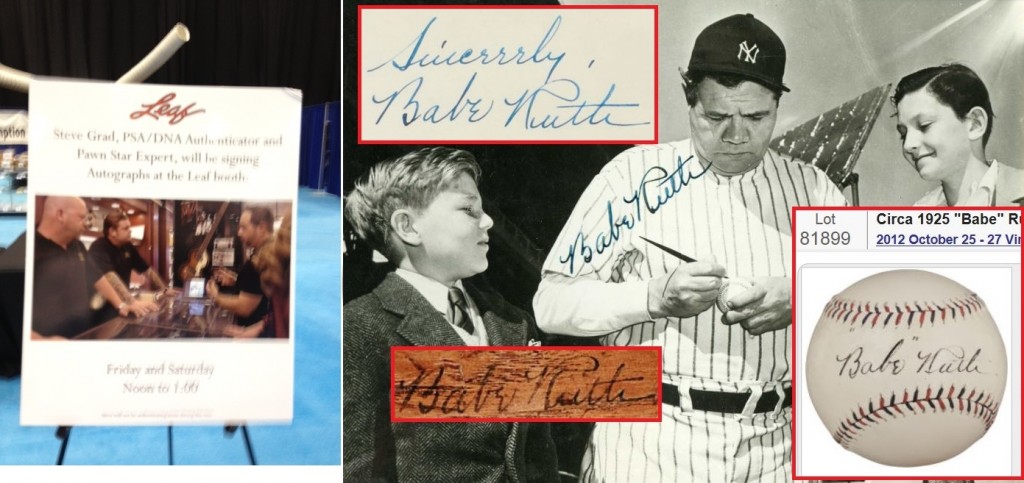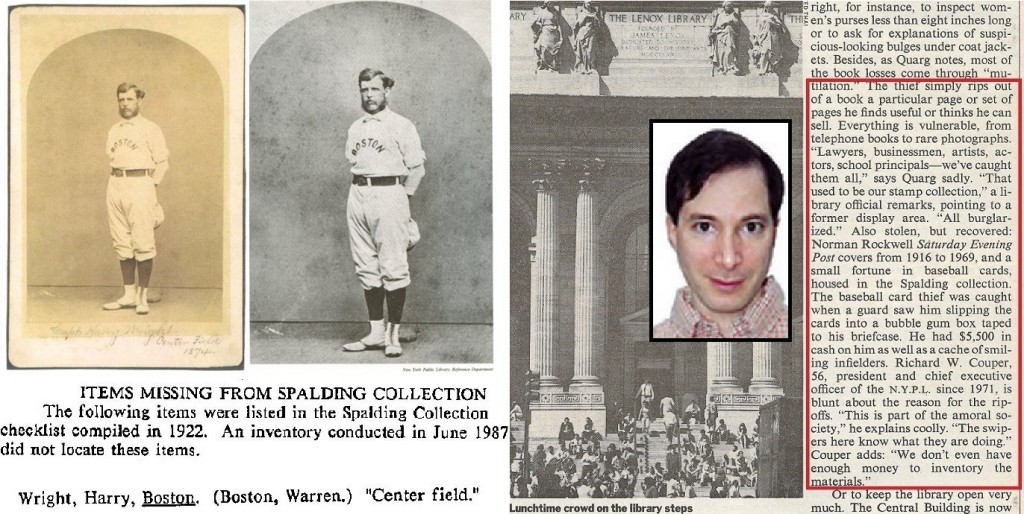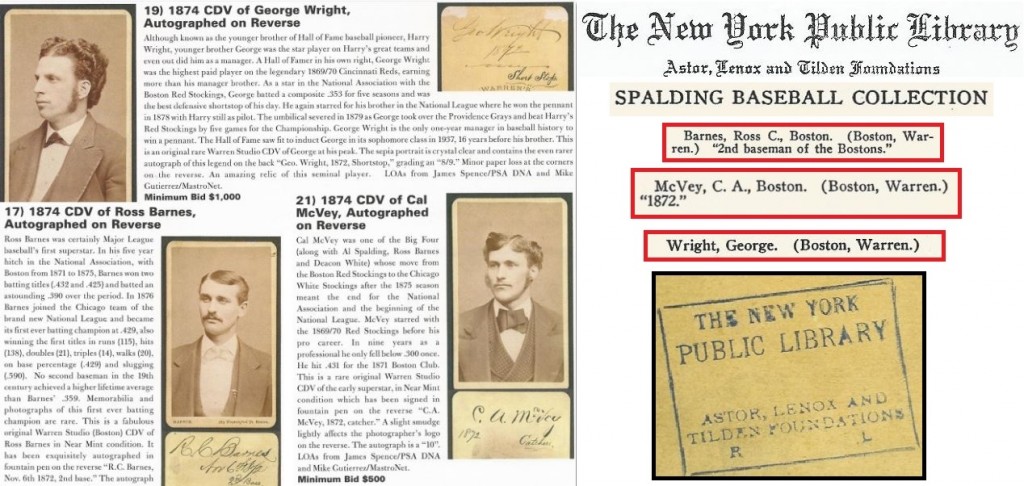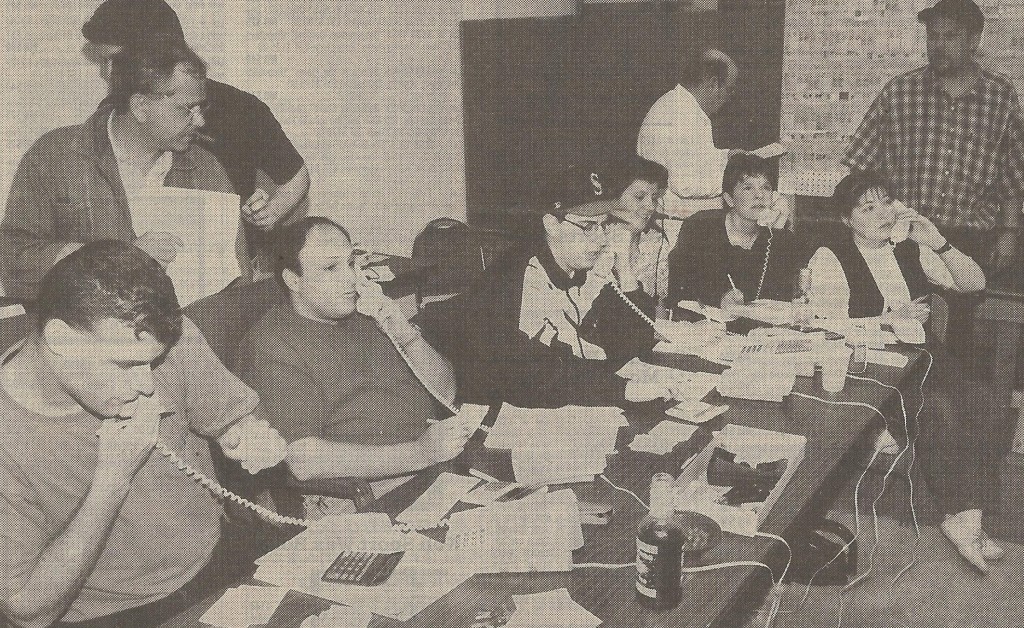By Peter J. Nash
February 20, 2014
|
![ruth pocket watch]() Heritage is selling what they say is the most important baseball artifact in existence, Babe Ruth's 1923 WS pocket watch. But is it the actual watch that was presented to the Babe in 1923 and why did Barry Halper say he owned one too? |
It’s the stuff that legends are made of.
The great “Bambino” passes along one of his treasured World Series awards as a gift to a close friend who, in turn, passes it along to his nephew who used to caddie for the “Sultan of Swat” at a golf course in Queens, New York. The former caddy’s widow says Babe Ruth was a life-long friend and that her husband even left his own wedding reception to visit the golf course clubhouse where the Babe toasted his nuptials. Over the years the Babe signed baseballs and photos for the family and at some point they even acquired what they claim is the Babe’s own locker key-tag marked with the number “3.”
It’s a remarkable story and in today’s sports auction landscape its just the type of tale that aggressive auctioneers want to hear when consignors bring them their personal treasures to sell. Just recently the Babe’s 1920 Yankee road jersey was purchased for $4.4 million by movie mogul Thomas Tull so, when someone told Heritage Auctions they had the Babe’s World Series hardware from 1923, auction director Chris Ivy saw dollar signs….big ones. As reported by the Associated Press, Heritage and Ivy say they have Babe Ruth’s World Series pocket watch from 1923 and they predict it could fetch close to a million dollars at auction thanks to the priceless story attached to it. It’s just further proof that George Herman “Babe” Ruth is still the king of the billion dollar baseball memorabilia industry.
Up on the auction block at Heritage with an alleged current bid of $425,000 (Heritage regularly places their own house bids on lots in order to get them closer to secret reserves) is a 14k gold Gruen “Verithin Pentagon” pocket watch that was allegedly presented to Babe Ruth in recognition of his first world championship in Yankee pinstripes. The auction house with its headquarters in Dallas, Texas, is pulling out all stops to promote its consignment as the auction catalog states, “As Babe Ruth’s personal award for the first World Championship in New York Yankees franchise history, this is arguably the most important article of sports memorabilia that exists.” Even Forbes is telling its readers they should buy the Babe’s pocket watch.
It all sounds too good to be true. All that’s missing is a Heritage press conference introducing the Babe’s old caddie recounting his first person tale of Ruth’s mulligans and his relationship with his hero. But that’s impossible, since Lewis Fern passed away last August at the ripe old age of 95 with full military honors. Fern not only caddied for the Babe, but he was also a World War II veteran who served his country as an Army Captain and paratrooper. Considering the timing of his passing, you might think his heirs are the ones putting his treasured Babe Ruth watch up for sale as part of his estate, but that’s not the case. That’s where this Ruthian story gets kind of complicated.
![fern schwefel ruth photo]()
Charlie Schwefel was friends with Ruth and was photographed with him in the press (top right). Ruth and Schwefel signed this photo (left) for his nephew, David Fern, whose brother, Lewis Fern, caddied for Ruth when he played at the St. Albans Golf Club in Queens (bottom right). The watch being sold by HA has "To My Pal Charles Schwefel" engraved on the interior case (bottom left). (Photos courtesy of the Fern Family).
Heritage claims that when Ruth was battling cancer in 1948 he “asked his close friend Charlie Schwefel if he might want anything from his collection to remember him by.” Schwefel, the auction house claims, “Asked for his dying friend’s pocket watch.” But the story isn’t told by Schwefel or his immediate family because, according to Heritage, Schwefel kept the watch for only two years and then passed it along to his nephew, Lewis Fern, who they say caddied for Ruth many times at the St. Albans Golf Club in Queens, New York, in the 1930’s. Heritage is relying on a letter of provenance in their possession signed by Fern and they say he “kept the watch for decades until it was privately sold into one of the finest sports collections in the world in 1988, where it has remained hidden away until now.”
In a press release Heritage describes in more detail the watch and its Ruth provenance stating, “The “Babe Ruth” engraving at the upper edge was added by the Babe himself just prior to gifting the symbolic memento to Schwefel. The rear case pops open to reveal further engraving, most notably the original text announcing, “Presented by Baseball Commissioner to George H. Ruth.” Just above we find the rest of Ruth’s late 1940s addition, reading, “To My Pal Charles Schwefel.”
![ruth watch HA engraver comparison 2]()
The 1923 Yankee World Series watches were all hand engraved and unique. The details of the heads of each player and the ornamentation surrounding the word "Yankees" illustrate this best (see red highlight). The alleged Ruth watch offered by Heritage (left) is missing areas of engraved shading on each side of the engraved words "World's Champions" on the genuine watches of Yankee exec Ed Barrow
Each of the watches presented to Ruth and his Yankee teammates is an expertly crafted timepiece which incorporates a hand engraved scene of a pitcher tossing a ball to a batter and a catcher. Every detail depicted on each watch case, ranging from the face of each player to the folds of each uniform, is unique to each timepiece. But the most notable difference between other genuine 1923 Yankee watches and the Heritage Ruth watch is the two missing sections of engraved shading to the left and right of the “Worlds Champions” inscription. This shading appears on every watch we examined including examples presented to players Wally Schang, Charles O’Leary and Harvey Hendrick.
Inside the authentic watches, there is yet another section which was engraved in block letters to identify the actual player being honored; it is the only element found on each watch that links it to the ownership of the individual players. It is also the easiest element for forgers to replicate and transform authentic awards presented to utility players and scrubs into the hardware awarded to the greats of the game.
That being said, Heritage’s Chris Ivy also told the AP, “No one knew where the piece had been. No one has ever seen it for public sale or public auction. The fact that there was no news about it for so many decades, it was just thought that at some point it had been lost to time.” Considering Ivy’s statement, how could he and Heritage ever know that Babe Ruth personally added engraving for his friend to the watch up for sale? How could they ever know if Ruth had his own name engraved on the outside case of the watch when none of the other surviving 1923 watches has a players name in the same spot?
Then, add to Heritage’s speculation the fact that the Babe’s own granddaughter, Linda Ruth Tosetti, has long believed that her grandfather’s World Series awards were wrongfully removed from a family safe deposit box at the time of Claire Ruth’s death in 1976.
Not to mention that the 1984 New York Yankees Yearbook featured a list of Yankee partner Barry Halper’s top 29 Ruth items and included “Babe Ruth’s 1923 World Series gold pocket watch” as the number “4″ relic in an article written by Bill Madden. In 1989, Phil Pepe of the New York Daily News also listed the pocket watch among Halper’s greatest Ruthian treasures. Halper was obsessed with collecting Ruth items and told Pepe, “People know I’m a fanatic when it comes to Babe Ruth. So they call me and offer me things.”
![halper NYY yearbook ruth list 1]()
The 1984 Yankee Yearbook lists Barry Halper's 1923 Ruth pocket watch as the number "4" item in his Ruth collection. In 1989, the watch was also mentioned as one of Halper's best Ruth items by Phil Pepe of the Daily News.
And if all that’s not enough to spark some speculation about the Heritage offering, there is the long-standing baseball legend which says Leo “The Lip” Durocher was caught stealing one of the Babe’s prized watches from his hotel room when he was with the Yanks in 1925. In his 2001 autobiography, Elden Auker, also claimed that Ruth had a fist-fight with Durocher after he’d caught him stealing marked bills from his hotel room. Years after Ruth’s death Durocher denied ever swiping his watch as he told a reporter, “You didn’t have to steal Babe’s watch,” he said. “If you liked it, he gave it to you.”
So where did this particular 1923 World Series pocket watch come from and what is its actual chain of ownership? The recent Associated Press report sheds some light on the subject by revealing some information about the current consignor of the watch. AP says, “The present owner, who wished to remain anonymous, declined to be interviewed. He said through Heritage that he acquired the watch for around $200,000 and was parting with it now to help fund charitable organizations important to him.”
Hauls of Shame interviewed Lewis Fern’s son, Dwight Fern, of Atlanta, Georgia, who had a conflicting recollection of the sale of his father’s watch. When asked if the watch sold for $200,000 Fern said, “That’s not true, he sold it to somebody in Atlanta, I don’t know who, and it wasn’t $200,000, it was like $85,000. Maybe they passed it on from there.”
The person from Atlanta he sold it to was gynecologist Dr. Goodman Espy III via collector and dealer Darrel O’Mary. In an interview with Hauls of Shame Espy said he couldn’t remember exactly what he paid for the watch and referred us to Darrell O’Mary who he said had the letter signed by Fern. O’Mary spoke about the deal and said, “Back in the early days when he was so inspired to build a collection, Dr. Espy didn’t have much knowledge and I sort of became (his) gate keeper for any potential purchases.” As for the discrepancy on the sales price O’Mary declined comment and said he never owned the Ruth pocket watch and added, “I can not weigh in on that. I just cannot professionally do it.” The sale of the watch was one of the largest transactions in baseball memorabilia history at a time when Bill Mastro had just sold his trimmed T206 Honus Wagner for a record price of $110,000.
When we asked O’Mary who actually discovered the watch he said, “I can’t remember if Mr. Fern called me or Dr. Espy but at the time he was excited about it and very liquid and that was by far the most he’d ever spent for an item. He was thrilled to get it.” Both men were also very comfortable with Lewis Fern’s representations about the watch and O’Mary recalls, “Lewis Fern was just such a gentleman and class individual, we never doubted its authenticity.” O’Mary says that neither he or Espy were aware at the time of the purchase that Barry Halper claimed he already owned the Babe’s 1923 Series watch.
![fern portrait]()
Lewis Fern (left) sold the 1923 WS watch for at least $85,000 in 1988. In a handwritten note from a family album (center) Fern recalls Ruth giving him the watch which was photographed before it was sold (right).
At the time of the sale O’Mary recorded Fern’s recollections about the watch in his own writing and had Fern sign the document. This is the same letter that Heritage currently quotes in its lot description but when we asked O’Mary for a copy of that document he declined and said, “Just out of courtesy I’d have to get permission from the auction house.” O’Mary did, however, confirm that Fern was told “This should have been yours all along” when he was given the watch by the Schwefel family. O’Mary said, “That actually came out of (Lewis) Fern’s mouth.”
When we asked Heritage’s Chris Ivy for Fern’s “letter of provenance” described in the lot description he refused to produce a copy and replied, “A copy of the letter will be provided to the winning bidder and the description in the catalog accurately reflects its contents.”
Ivy’s reluctance to make the letter public led to our interview of Fern’s widow, Marion Fern, who offered another account which conflicted with the Heritage auction description. Fern told us the watch was given to her husband by Elsie Schwefel when one of her sons had passed away. ”My husband was with (Billy Schwefel’s) mother during part of the funeral and evidently she was supposed to give the watch to Billy, that was one of the sons, and Billy had died, so she passed it on to my husband who they were all close with.” Dwight Fern recalled that Schwefel funeral took place in the early 1960’s.
Dwight Fern also noted that he recalled seeing the Ruth pocket watch when he was a child. “I think I was about seven years old, I never saw the engraving to Charlie Schwefel. I never saw that but the rest of the engraving was there.” Fern provided us with an image taken of the watch when it was still in his father’s possession. That image shows the “Babe Ruth” engraving on the exterior of the watch but when asked if his father took a picture of the interior engraving Fern said he just learned about that engraving in the Associated Press reports that appeared nationally. ”I don’t think he did because that was new to me when I read that in the article. The engraving was on the inside and I never opened it up like that,” said Fern. Also appearing in the picture of the watch was a handwritten note written by Louis Fern that differs from the accounts given by his wife, O’Mary and Heritage. Fern wrote, “Babe Ruth gave me his World Series (1923) watch-’he liked me’ I caddied for him.”
Television producer and author, Cyndi Todd, of Atlanta, Georgia, has been working on a biography of Lewis Fern called A Paratroopers Purpose and in her interviews with him before his death discussed his relationship with the Babe and the pocket watch. ”The Babe Ruth story is one of the cornerstones of my book,” said Todd who added, “Lew told me that he got the watch from his Aunt Elsie after his Uncle Charlie passed away.”
![1923 WS watch yankees 6 w roth]()
The alleged Ruth watch being offered by Heritage (outlined in red) joins seven other surviving and authentic watches that have been sold at public auction. The watches were presented to Yankee players and executives after the 1923 World Series.
While Fern got his watch from his Aunt Elsie, the Yankee players and executives got their gold pocket watches from Judge Landis and it wasn’t until 1927 that the Babe received his first World Series ring. Ruth later added rings with world titles in 1928 and 1932, rounding out his collection with a total of three diamond-studded rings along with the 1923 gold pocket watch. All of them, except for the Babe’s alleged 1927 ring currently in Charlie Sheen’s possession, had remained AWOL until the 1923 pocket watch recently appeared in an Associated Press report and on the cover of the catalog for Heritage’s “Platinum Night’ auction in New York City on February 22nd.
Authentic and surviving examples of the 1923 Yankee pocket watch created by Gruen are exceedingly scarce and only a handful (approximately eight) have appeared for sale at public auction in the past few decades. Even the museum at Yankee Stadium could only manage a replica watch for its display. Genuine examples attributed to Yankee executives Ed Barrow, Mark Roth, Paul Krichell and R. J. Connery, however, have surfaced as well as one presented to team trainer “Doc” Woods. To date, the only player watches known to have survived in private hands are the ones Judge Landis presented to to Wally Schang, Charles O’Leary and George Pipgras. In 1991, Sports Illustrated published a story chronicling how Pipgras’ 1923 watch was stolen from him at gunpoint in the 1930’s and found over 50 years later by a pawn shop owner who sold it back to the family for $500. The Baseball Hall of Fame also has a player watch presented to Harvey Hendrick and another that belonged to Judge Kenesaw Mountain Landis.
![ruth watch HA 3]()
The engraving on Heritage's Ruth watch (top left) starkly contrasts the engraving found on the genuine watches presented to Yankee executives Ed Barrow, R. J. Connery and Mark Roth.
The “long-lost” example currently being offered by Heritage clearly has a credible provenance story that shows how the watch was transferred from Charlie Schwefel to his nephew Lewis Fern. There are, however, several inconsistencies in that story that could very well be the product of some exaggeration or family legend that developed over the decades. Putting that story and those facts aside, however, this 1923 pocket watch has other visible issues totally unrelated to its chain ownership. The most interesting issue appears to be the interior engraving that starkly contrasts the work inscribed into the 14K surfaces of the known genuine examples presented to the Yankee executives. The next prominent issue is that the Heritage offering has case and movement serial numbers that also do not appear to correspond with all of the other existing 1923 Yankee Gruen watches.
![1923 WS ruth watch serial no]()
The serial number engraved on the Heritage Ruth watch is not in the same sequence as the numbers engraved on previous authentic watches sold by Heritage which were once presented to Yankee execs Ed Barrow, Mark Roth and R. J. Connery.
The serial number engraved on Heritage’s Ruth watch (1060722) is approximately 3,500 numbers away from the series of numbers found on the other genuine 1923 Yankee watches previously sold by Heritage. Unconfirmed reports state that Gruen sold about 50,000 “Verithin” model watches annually which would mean that the alleged Ruth watch was made months after all of the other known examples.
![1923 WS watch Ruth HA movement v Roth HA movement]()
The serial number on the Gruen movement of the Ruth watch is "526564" while the watch presented to Mark Roth has the number "518470."
In addition, the serial number found on the actual Gruen movement inside the gold case of the Ruth watch is separated from the other known examples by close to 8,000 digits, thus further suggesting the Heritage offering was created well after the others were assembled. Why?
For comparison, another 14k Gruen Verithin Pentagon pocketwatch was offered on eBay recently and was engraved with an inscription dated “March 25, 1925.” The watch was a 21st birthday present and was accompanied by the original presentation box and the Gruen certificate which included the record of its $100 sales price.
![gruen verithin ebay 4]()
A similar Gruen Verithin watch was offered on eBay and was inscribed with a date of March 1925. The case number was "1070849" and the movement number was "541668." The watch came with its original papers and was priced at $100 in 1925.
The case number on the watch, which was presented and engraved in March of 1925, was “1070849″ and the watch movement serial number was “541668.” The Yankee watches were presented to the players on Opening Day which fell on April 23, 1924. With the known genuine Yankee watches having case numbers ranging between “1057335″ and “1057343″ and movement numbers in the “518470″ range, the 1925 eBay watch further suggests that the Heritage Ruth watch was assembled after the other Yankee watches were created because its case number is “1060722″ and its movement number is “526564.”
The Gruen Watch Company was founded in the late 19th century and at the time the Yankees were presented with their watches, Fred Gruen had already taken control of the Cincinnati company after the death of his father who founded the company. All of the Gruen watch cases and movements were imported from Switzerland and assembled in Ohio and Toronto. A local Cincinnati jeweler named Frank Herschede was the dealer who actually sold Baseball the Gruen watches as referenced in a Cincinnati newspaper that published an image of one of the Yankee watches before they were presented by Judge Landis.
![1923 WS watch NYT jan 1924]()
In January 1924 the New York Times reported the Yankee World Series watches might be presented to the team at Spring Training (left). Yank exec Paul Krichell's 1923 Yankee watch survived with its original presentation box from Cincinnati jeweler Frank Herschede. An item from a 1924 Cincinnati newspaper (right) illustrated one of the engraved watches sold by the firm.
It is possible that the Gruen watches sold by Herschede were chosen by the Commissioner’s office because the Chairman of Baseball’s National Commission, August Herrmann, had been based in Cincinnati since the turn of the century and Herschede was also a stockholder in his Cincinnati Reds franchise. The August Herrmann Papers collection at the National Baseball Library includes files of correspondence from Herschede as well as the papers of Judge Landis and his office during 1923 and 1924. It’s possible there might be some additional documentation of Landis’ purchase of the watches for the Yankees, however, the National Baseball Library has been closed to the public since two key library employees, Tim Wiles and Freddie Berowski, recently left the Hall to take positions at other libraries.
That being said, when we questioned Heritage’s Chris Ivy regarding the fact that the interior engraving on the Ruth watch contrasted the engraving found on other executive and player watches, Ivy claimed to have documentation in his possession proving the watch was the exact same one presented to Ruth by Judge Landis on Opening Day 1924.
![1923 WS watch NYT april 23 group]()
The NY Times reported Judge Landis cancelled the Yankee watch ceremony on Opening Day (1924) but later reports (center) show that he did present them. Jacob Ruppert also gave gold watch fobs to his champs (right).
“In addition to the Fern letter, we also have correspondence from the period that not only confirms that the watch is engraved exactly as instructed by the Yankees organization and the Commissioner’s office, but provides additional data and facts that support that the watch that we are offering is 100% authentic and was the watch issued to Babe Ruth for the 1923 NY Yankees championship,” said Ivy in an email. Ivy, however, is not willing to make that information or the Fern letter public and added,”We also have data that ties this Ruth watch to the other presented 1923 championship watches in a very specific and clear manner.” According to Ivy the only person or persons who will be privy to this information are, “the winning bidder as well as any interested and qualified bidders that contact us prior to the auction close.”
While Ivy and Heritage have issued strong statements about their evidence, they still have no answer for the past claims that Barry Halper once owned Ruth’s 1923 pocket watch. With the inconsistencies in the known provenance stories and the fact that Heritage is apparently unwilling to share information they claim proves Ruth was presented their watch on Opening Day 1924, we can only look to the surviving pocket watches to try and unravel the mystery of Ruth’s Yankee bling.
We consulted with one of the nation’s top experts on Gruen watches and presented him with all of the evidence we’ve compiled related to the ten Yankee watches known to have survived. Charlie Cleves, from Bellevue, Kentucky, is the owner of Cleves and Lonnemann Jewelers and is also one of the few people in the country who have acheived the rank of “Certified Master Watchmaker 21st Century (CNW21)” after passing testing administered by the American Watchmaker and Clockmaker Institute’s Board of Examiners. Cleves, who also has his own collection of Gruen “Pentagon” watches, examined images of all the known examples focusing on the engraving and manufacturing elements of each timepiece.
Cleves began with his analysis of the inconsistencies in the engraving and although he was somewhat concerned with the contrasting engraving on the Ruth watch told us, “Gruen had at least ten different engravers on their line during this time period and they would have different styles in their work. The engraving alone isn’t enough to rule this out.”
As far as the great disparity in the serial numbers on the watch movements as compared to the other Yankee executive watches Cleves said, “I would expect the movement serial number to fall in line with the other ones, but this discrepency could be explained away by the fact that Gruen would put a new movement in your watch if you sent it in for repairs.” So that could explain that issue.
But when it came to the the 3,500-plus number disparity in the serial numbers of the actual gold watch case and the known executive watches, Cleves told us, “I’m very concerned with this aspect.” Cleves did determine that all of the Yankee watches were made during 1924 but then added, “The simpler, more probable explanation is that it is a slightly higher case and movement number and it was made four or five months after the original ones.” The original ones Cleves was referring to were the Yankee executive watches sold by Heritage in previous sales. Cleves added, “Did he lose his watch or decide he needed a second one?”
![cleves company_storefront_1]()
Watch expert Charlie Cleves (inset) was able to determine the dates the 1923 Yankee watches were manufactured by examining the serial numbers on the watch cases.
If Cleves’ analysis is correct and the Yankee executive watches inscribed “Presented by New York Yankees” were made at the same time as the player watches inscribed “Presented by the Commissioner,” then it is highly improbable that the million-dollar Heritage watch given to Lewis Fern is the same watch presented to the Bambino on April 24, 1924. Based upon Cleves analysis, could the pocket watch have been a second one ordered by Ruth or the Yankees? When we asked Daryl O’Mary what he thought about the conflicting serial numbers he told us, “Let’s just say if this could have been a duplicate watch, I’m confident that Lewis Fern knew nothing about it.” As for the contrasting engraving issues O’Mary added, “I know Dr. Espy has not had any type of engraving added to it, I would swear under oath to that.”
Since everything seems to boil down to the actual 14k gold case serial numbers, is it possible that the Yankee executive watches were made months before the watches presented to the Yankees on Opening Day? One more mystery tied to this Ruthian saga is the fact that none of the Yankee player watches sold at public auction have included any images of the engraving and serial numbers found on the interior cases. Neither Lelands or Hunt Auctions provided photos in three different sales of Wally Schang’s watch. Hunt never pictured the interior case on trainer “Doc” Woods’ watch in 2004 and Charles O’Leary’s watch sold by Barry Halper at Sotheby’s in 1999 also failed to include a picture of the case. We couldn’t find any images of the other 1923 Ruth watch that Halper claimed to own in the 1984 Yankee Yearbook. That being said, many of Halper’s prominent Ruth artifacts ranging from his rookie Red Sox uniform to a lock of his hair have been exposed as counterfeits in reports that we published at Deadspin and the New York Post.
The Babe’s own granddaughter, Linda Ruth Tosetti, has been doing her own tracking of her family’s lost heirlooms and told us she called the Baseball Hall of Fame and found that they had only one player watch in the collection which was presented to Harvey Hendrick. Tosetti, however, could not determine what the serial number was. ”The Hall of Fame told me it was either out on loan or in a display case and that it wasn’t possible to get the numbers,” said Tosetti.
Tosetti even called up the grandson of Babe’s old teammate George Pipgras to see if he could share the serial number on the watch returned to his family after being stolen in the 1930’s. When Tosetti called Pipgras’ grandson, George Simpson in Inverness, Florida, he was unwilling to help solve the mystery and said his son in Jacksonville had the 1923 watch and Pipgras’ 1927 Series ring and that he was also unwilling to help. Tosetti told us, “He just blew me off and actually hung up on me. Geez, if Babe was alive to hear this he’d give them a piece of his mind. Here’s a family that recovered their watch due to the generosity of others and this is how they act?”
![linda ruth claudia williams fenway]()
Linda Ruth-Tosetti (left) has been searching for Babe's World Series awards; Dr. Goodman Espy and his ex-wife Cheryl (center); Heritage CEO, Steve Ivy (right).
Hauls of Shame also contacted the Pipgras-Simpson family and attempted to get a confirmation on the case serial number from George W. “Pip” Simpson, but the undercover cop who was recently in the news after shooting a suspect in a drug bust declined comment. George Simpson Sr. told us he hung up on the Babe’s granddaughter because he didn’t believe it was really her. ”How am I supposed to tell if it was really her,” said Simpson. Without any confirmation on the case serial numbers on the Pipgras, O’Leary, Schang and Hendrick awards, we still can’t be sure that the watch Heritage is offering is the Babe’s first Yankee hardware. Unfortunately, this mystery will continue until this information is researched further and verified. Could Heritage have confirmed this information and still be holding it back from prospective bidders and the general public? If it is revealed that the case numbers on player watches are close to the “1060722″ number on Ruth’s watch its safe to say that Lewis Fern really did have the genuine article. This mystery would be solved.
One thing that is not a mystery, however, is the fact that Heritage Auctions may not even have clear title to sell their million-dollar Ruthian treasure. In the course of our interview with consignor Dr. Goodman Espy he asked that his name not appear in our report because he had not revealed his ownership of the 1923 watch in a recent divorce proceeding with his ex-wife Cheryl Petros Espy of Atlanta, Georgia. When we simply asked Heritage’s Chris Ivy for the Fern letter and pointed out the inconsistencies in the engraving he threatened Hauls of Shame on Espy’s behalf stating, “Should you move forward to write and publish an article that includes inaccurate, misleading, and/or irresponsible speculation that causes financial harm, or otherwise, to our consignor, then you will simply be opening yourself up to further legal repercussions should he choose to pursue them.”
In response, we asked Heritage’s CEO, Steve Ivy, if he knew about the Espy divorce and if the auction house had verified that their client had clear title to offer the watch for sale. We also asked Ivy to address the prior claims made by Barry Halper that he actually owned Babe Ruth’s 1923 watch four years before Espy did? Ivy did not respond to our inquiry.
When contacted at her home in Atlanta, the consignor’s ex-wife, Cheryl Petros Espy, confirmed that her husband did not disclose his ownership of the Ruth pocket watch in their divorce proceeding but declined further comment.
(If you own the 1923 Babe Ruth World Series watch Barry Halper claimed to have in the 1980s or if you own another 1923 Yankee player watch with visible serial numbers please contact us at: Tips@Haulsofshame.com )
UPDATE (Feb 21): Heritage Auctions posted this update to the lot description of the 1923 World Series Pocket Watch:
1923 New York Yankees World Championship Watch Presented to Babe Ruth. Update: We are pleased to announce that in addition to a copy of the original signed letter of provenance from Lewis Fern, we have added the following documentation to the files that will accompany the watch:
1) Copies of fourteen pages of correspondence between the New York Yankees, the office of the Commissioner of Baseball and the watch company dating from late 1923 to early 1924 regarding the ordering of Championship watches. The precise manner of engraving is confirmed by this paperwork, as are the details of the watches’ construction that are specific to the 1923 championship watch order. Only eleven of the thirty-nine watches delivered to the team exhibit a full first name and middle initial as requested in the letter. George H. Ruth is one of those eleven.
2) A letter of provenance from the son of Lewis Fern, who sold the watch to our consignor over twenty years ago. This letter confirms all details of the elder Fern’s own letter of provenance as well as the fact that the watch remains identical in appearance to his earliest recollections of it as a child in the 1950’s.
3) We have discovered that the Championship watches issued to the 1923 Yankees, both front office and player versions, were very lightly hand-scratched with a five-digit code beneath the serial number. The codes are represented by a “46XXX” number and are consistent on all inspected examples, including the Ruth representation. We have determined that this coding was done prior to presentation to the recipients and appears to be present only on Yankee watches and absent on all other Gruen Verithin Pentagon examples we have located in our research. We will include photographic imagery of the other known Yankee watches to illustrate this trait that links each to the same specific population.
UPDATE (Feb 22): Hauls of Shame presented watch expert Charlie Cleves with Heritage’s updated information concerning the 5-digit numerals and he responded saying:
“The number inscribed underneath the serial number is usually put on by jewelry stores or watchmakers who work on watches. In this case it could have been put on by Herschede Jewelers when the hand engraving was done if they were the ones who engraved the cases and not the factory. If it is a job number put on by the jeweler and this watch was made the same time as the other one then the numbers would all be sequential. If there is a gap between this watch and the rest of them then I would think it was made at a later date (4 or 5 months later). It could be a number put on by Herschede to track the watch for warranty purposes. We still put a number very small on every watch we sell. We can always look up the number and know exactly what the price was, date of purchase and the person who bought it. So if it was something that Herschede routinely did then it would also be on a watch they made later and have a slightly higher number than the other ones.”
We then asked, “Would the actual serial number on the case be the most accurate element to determine the date of manufacturing?
Cleves responded:
“We can date watches we sold by our numbers we put in them going all the way back to 1932. The biggest problem arises from the fact that some watches sat 10 years in our showcase before they were sold to the customer. When you look up some of the Bulova watches that are date coded with the year of manufacturing it will be coded 1966(m6) and our card may say we sold it in 1972. Once Herschede went out of business I’m sure all of there files were destroyed. When the companies were going strong their serial numbers would be the best way to date a watch. Gruen was definitely tops in their field in the 20’s.”







